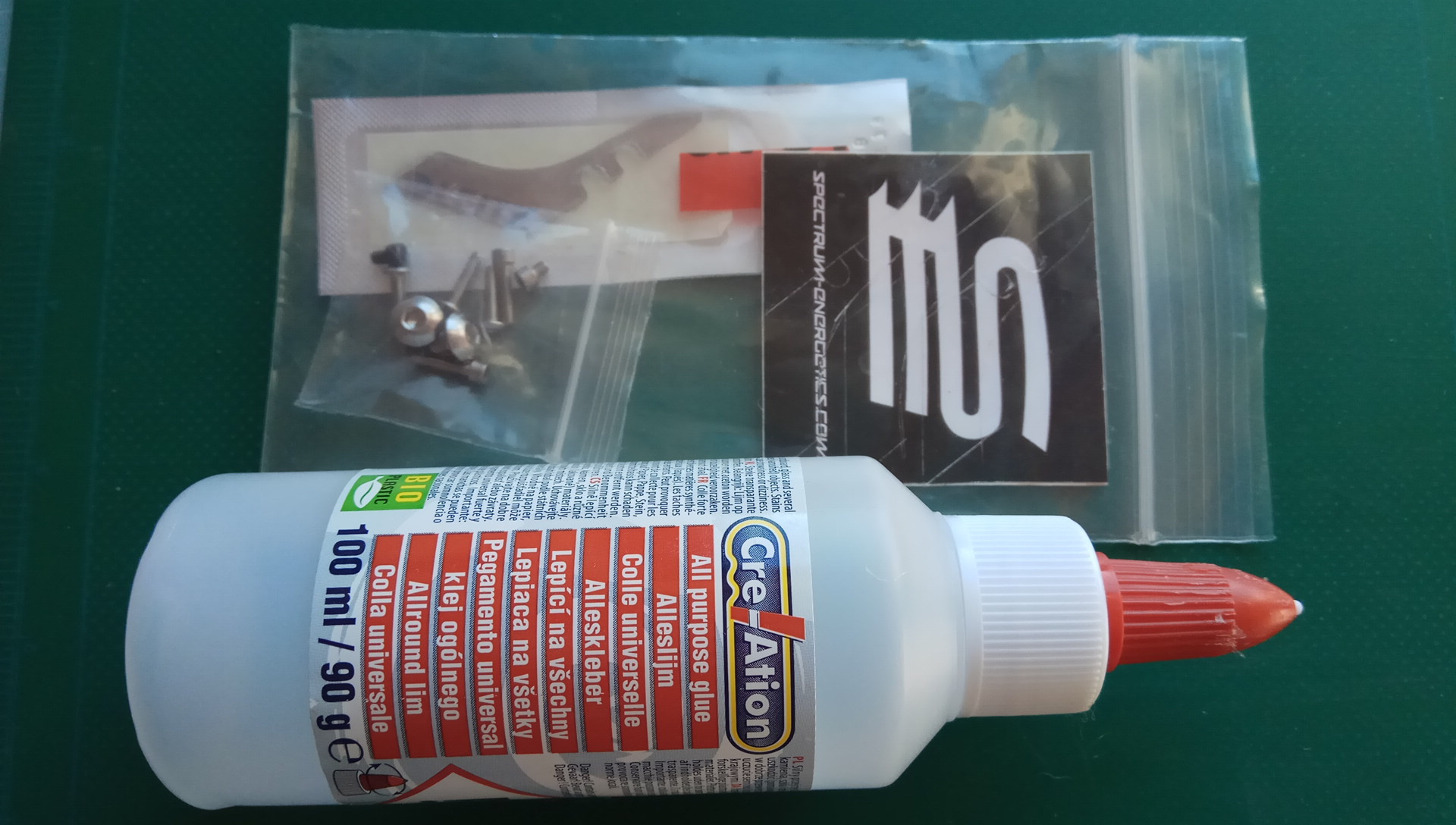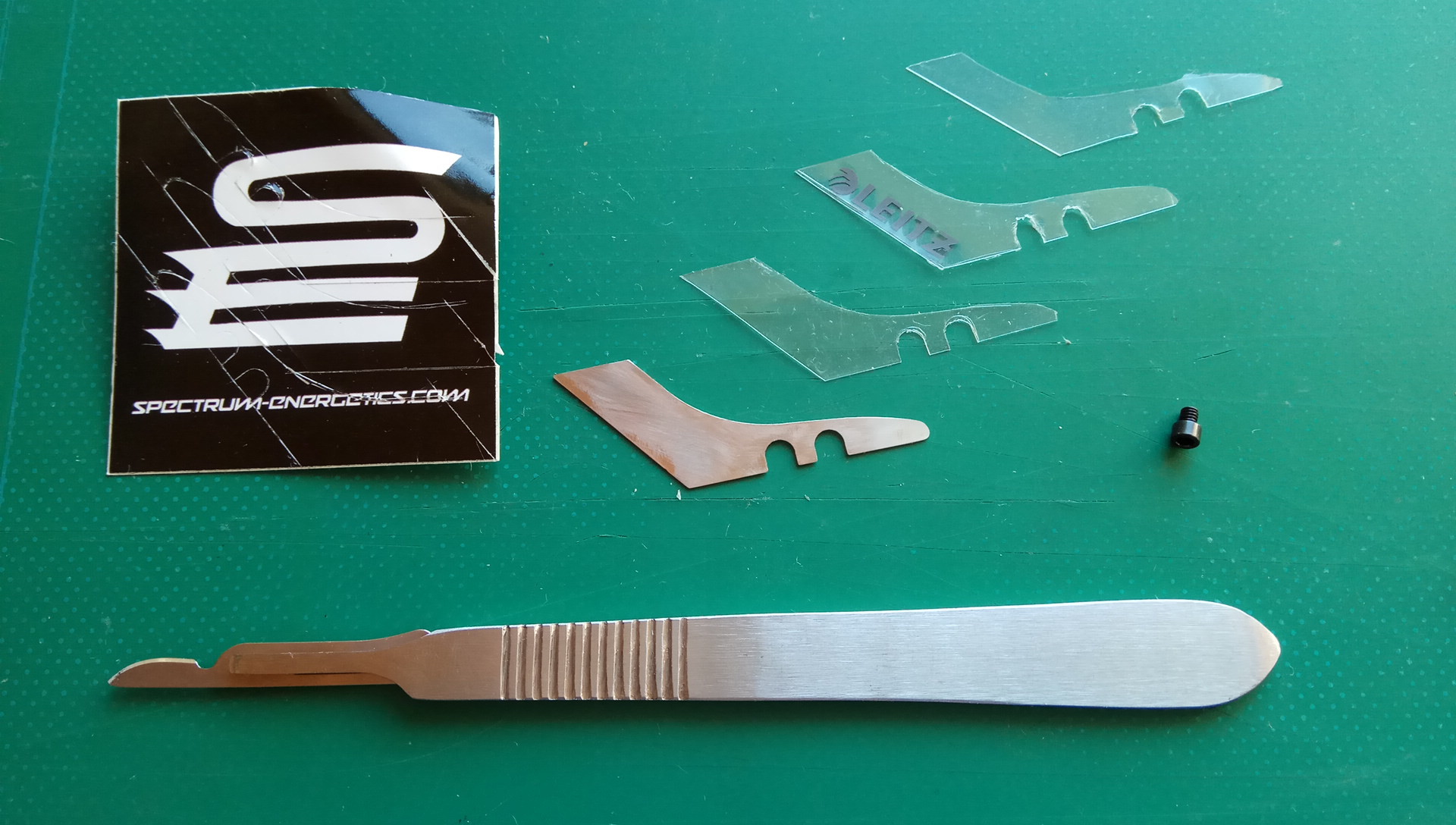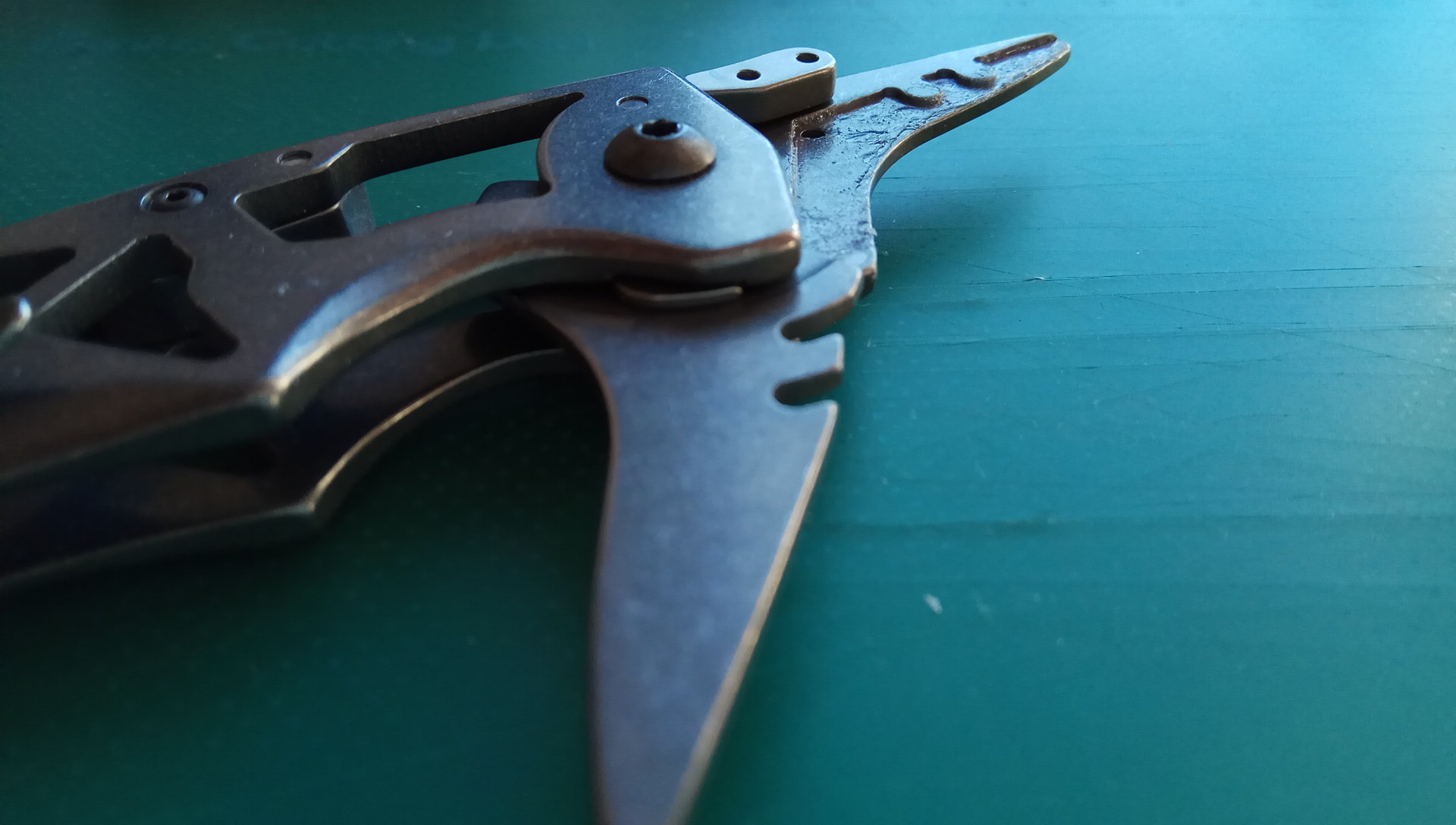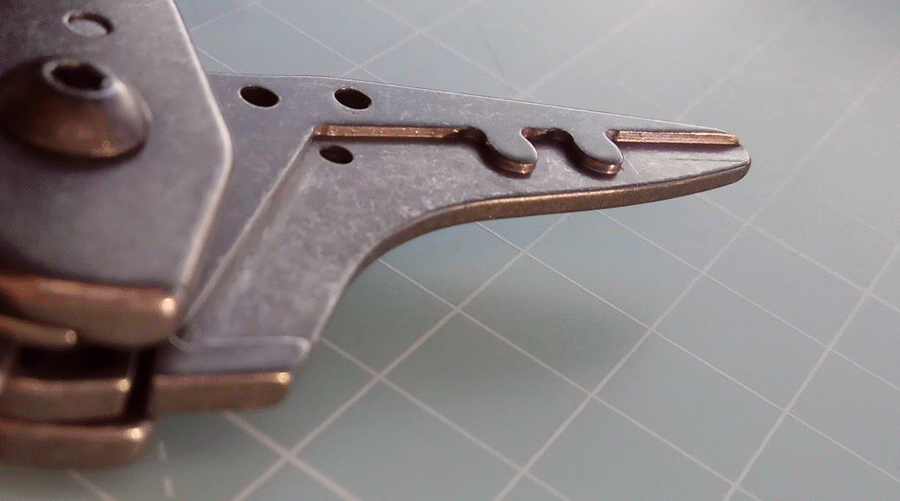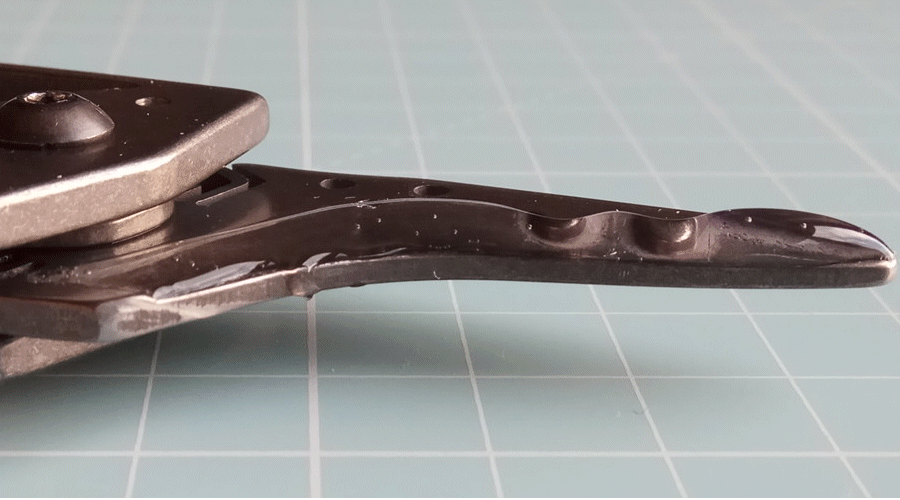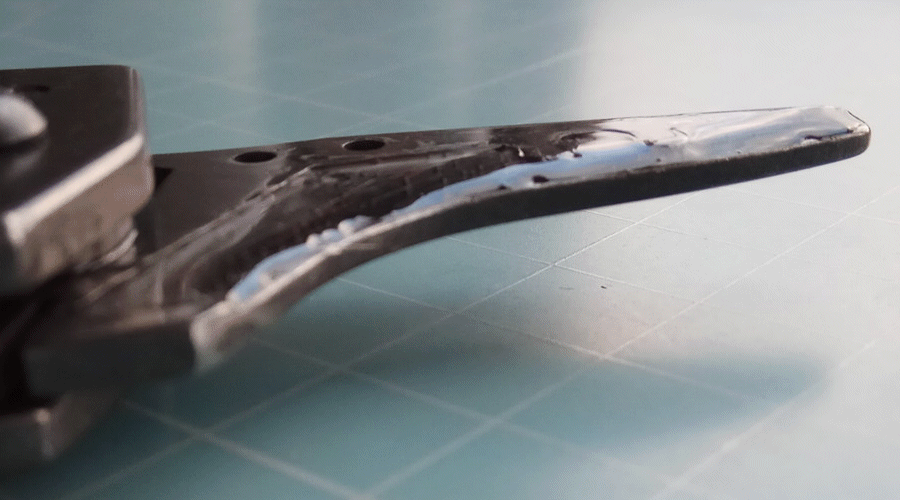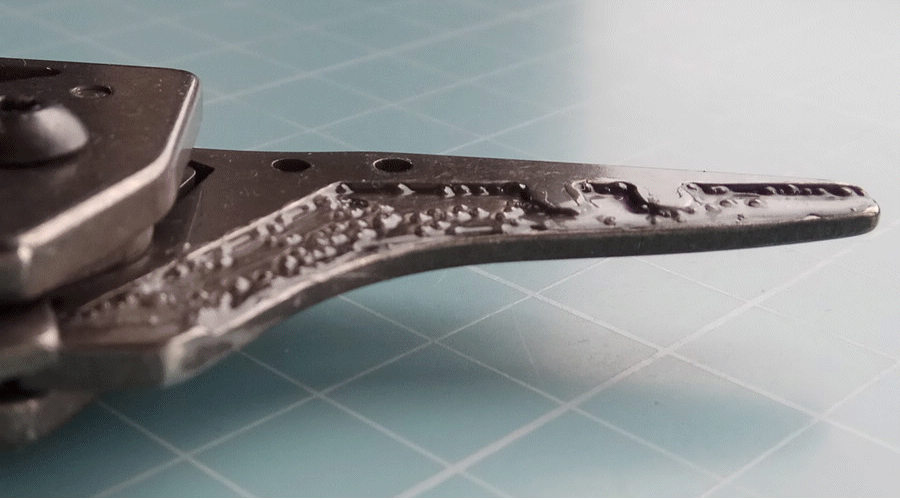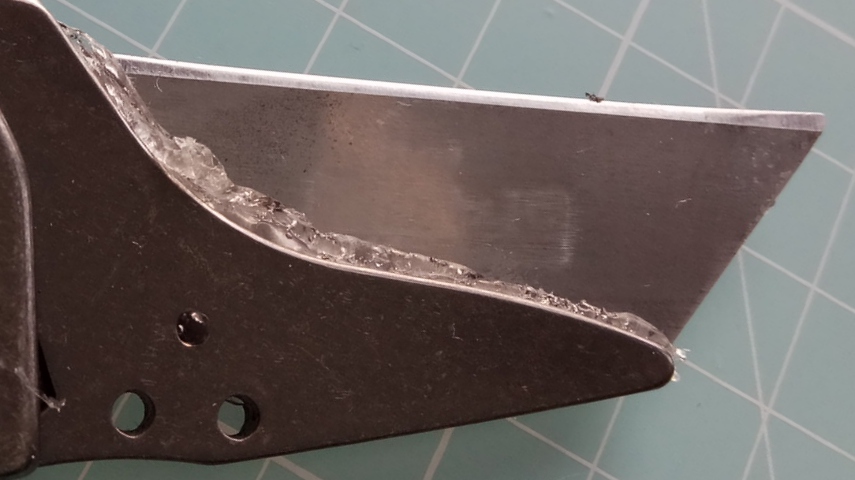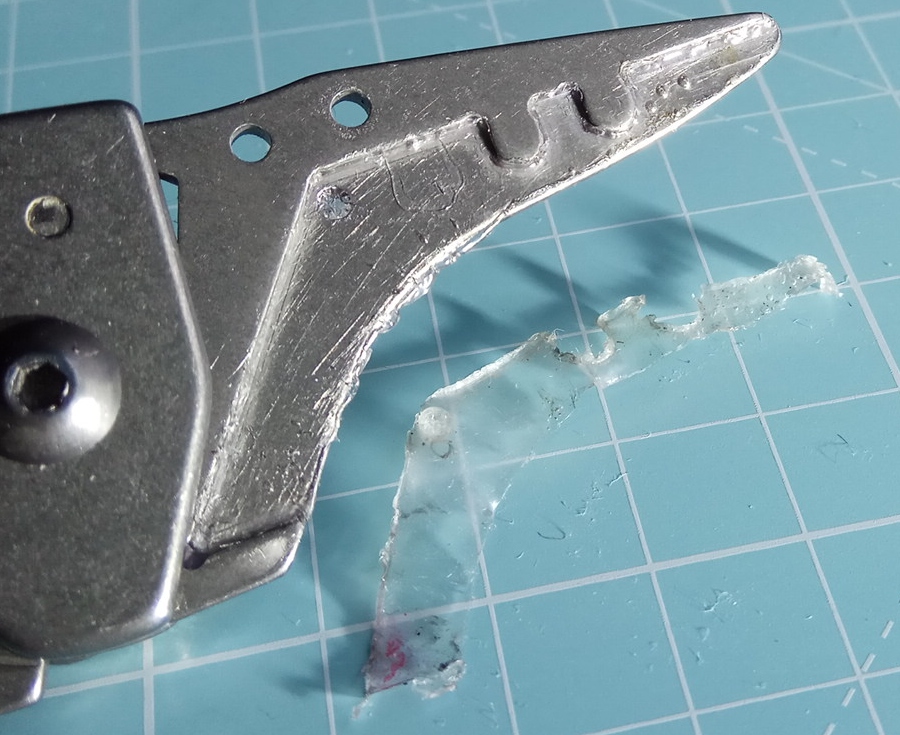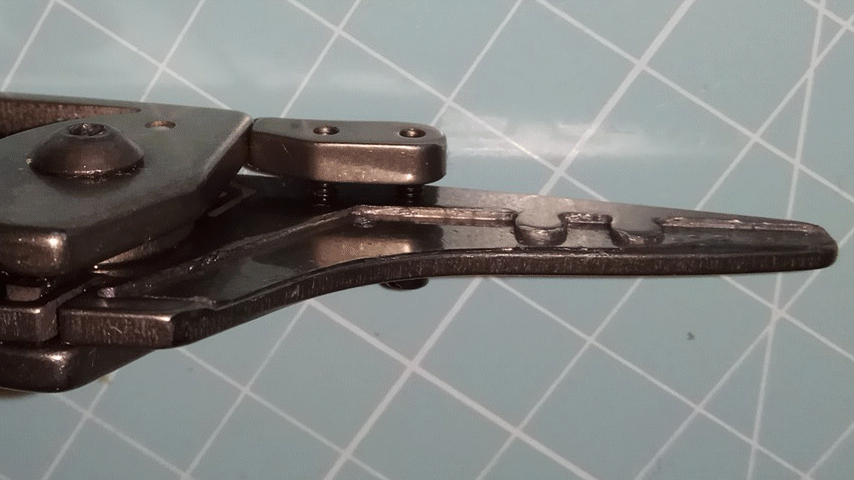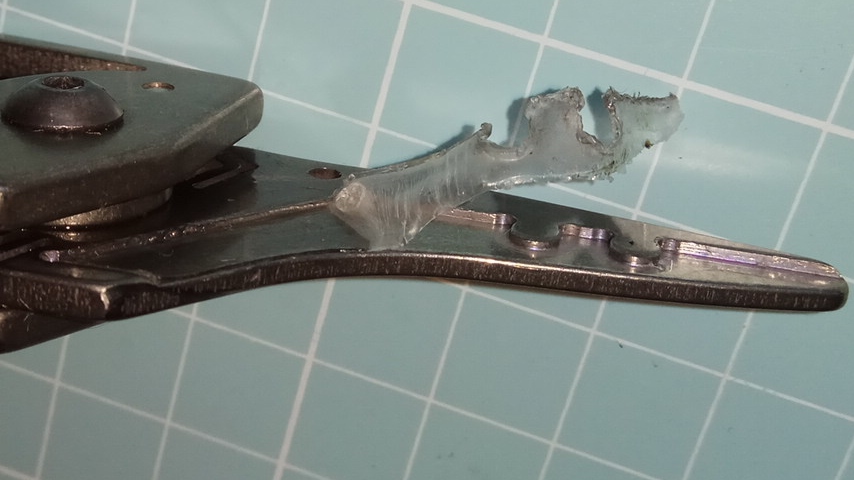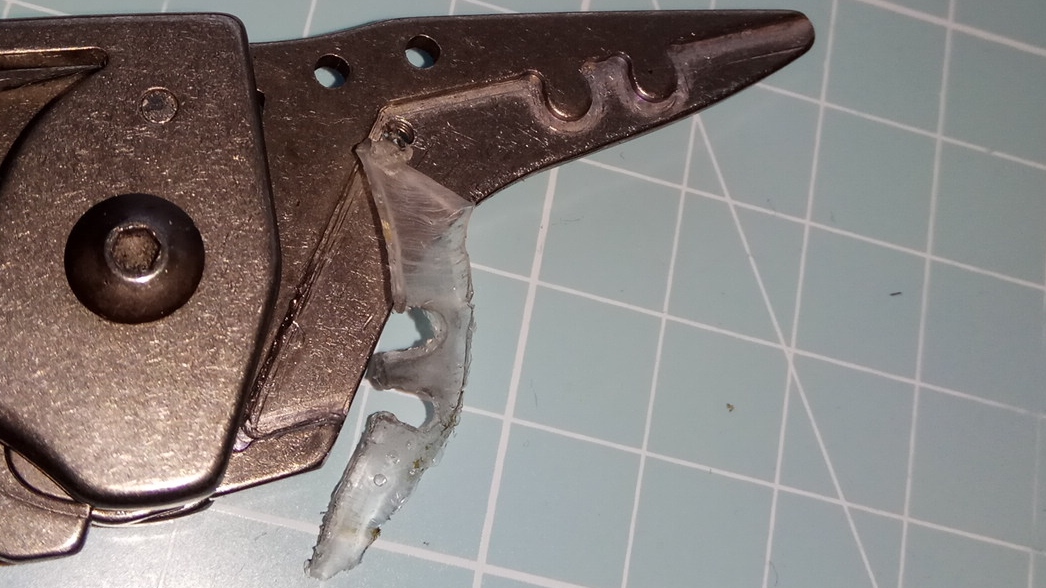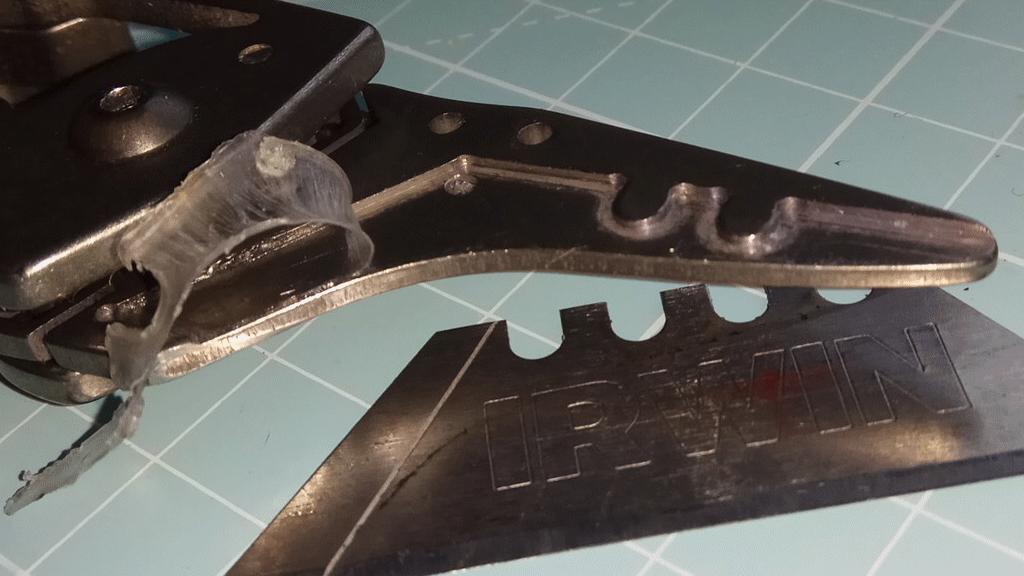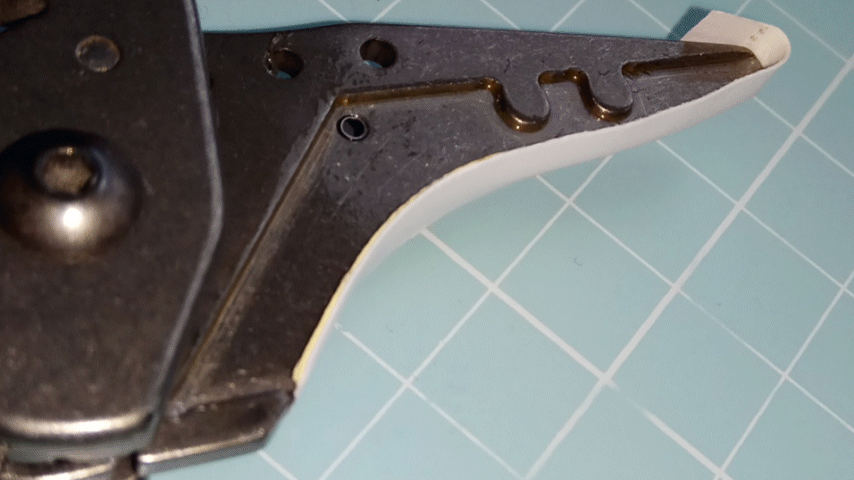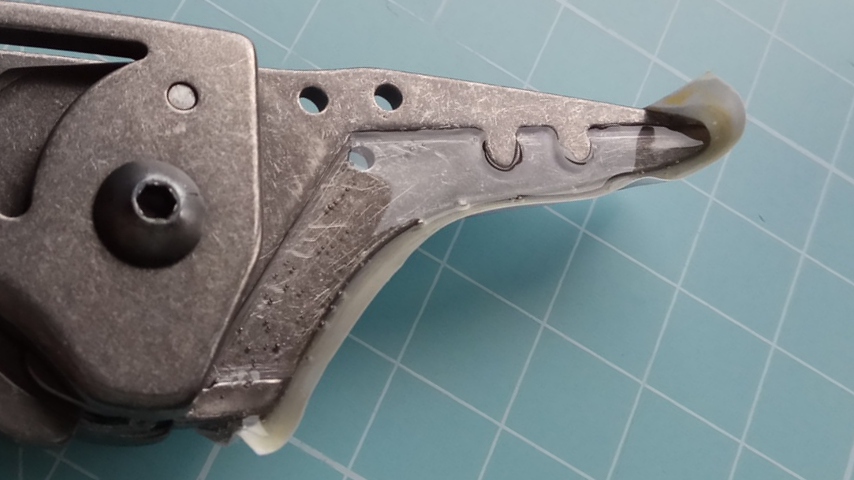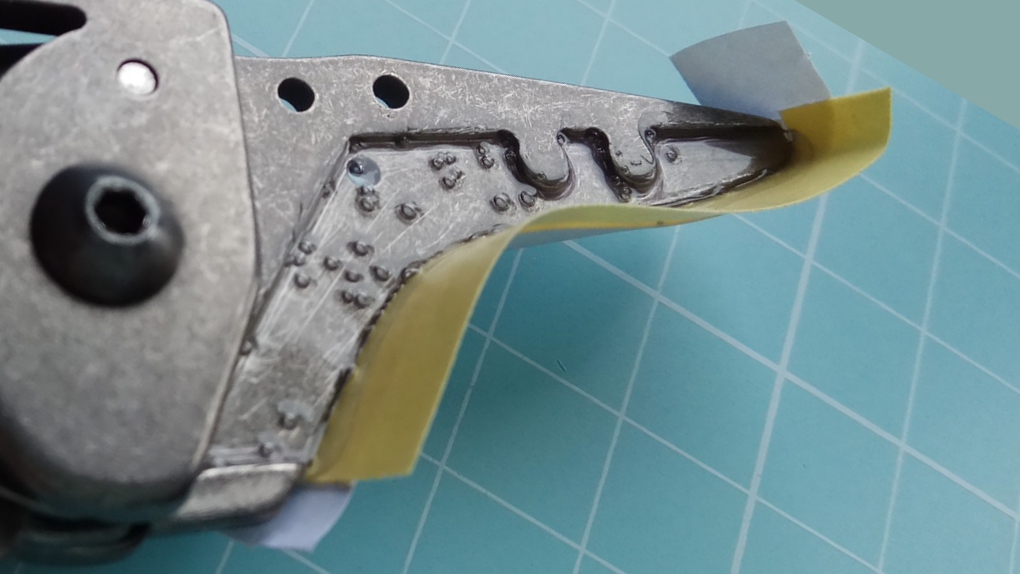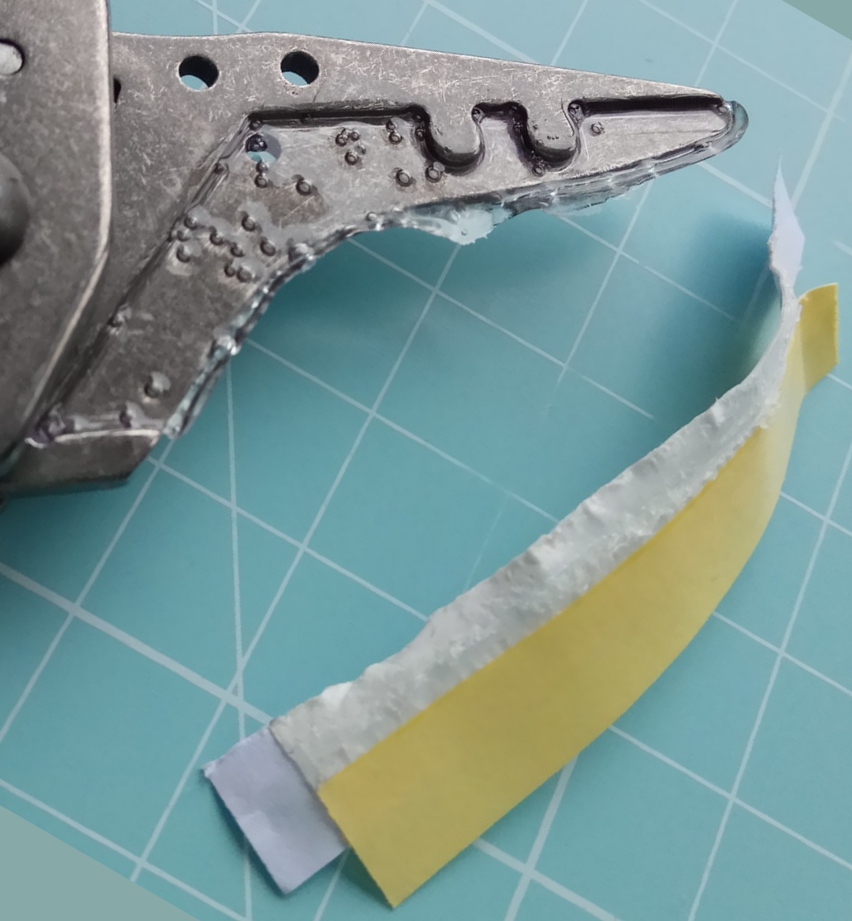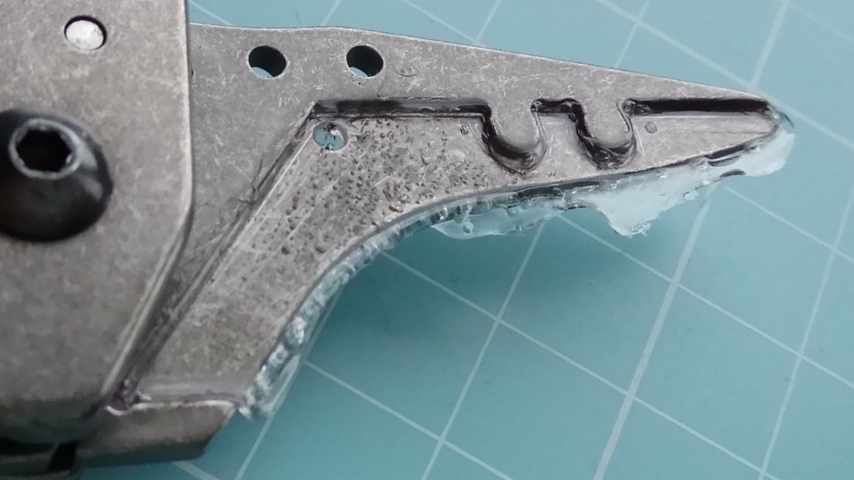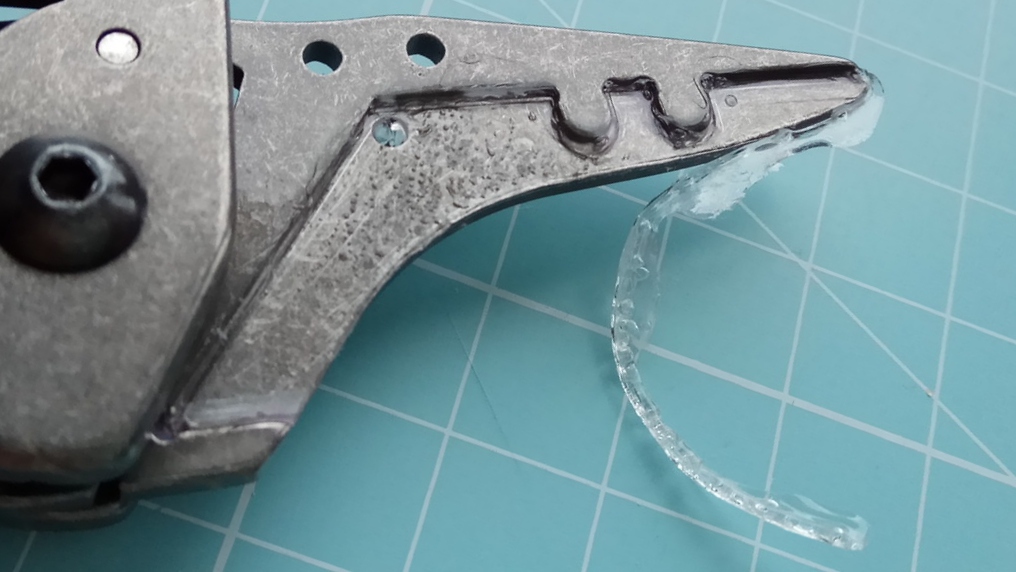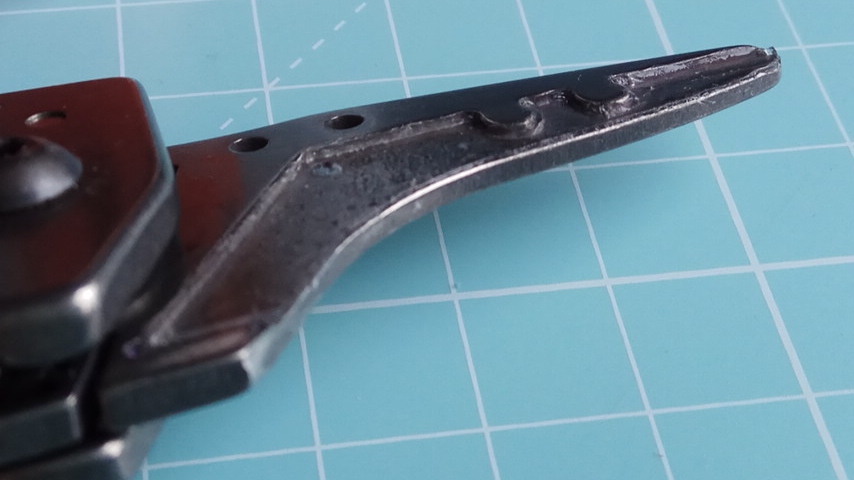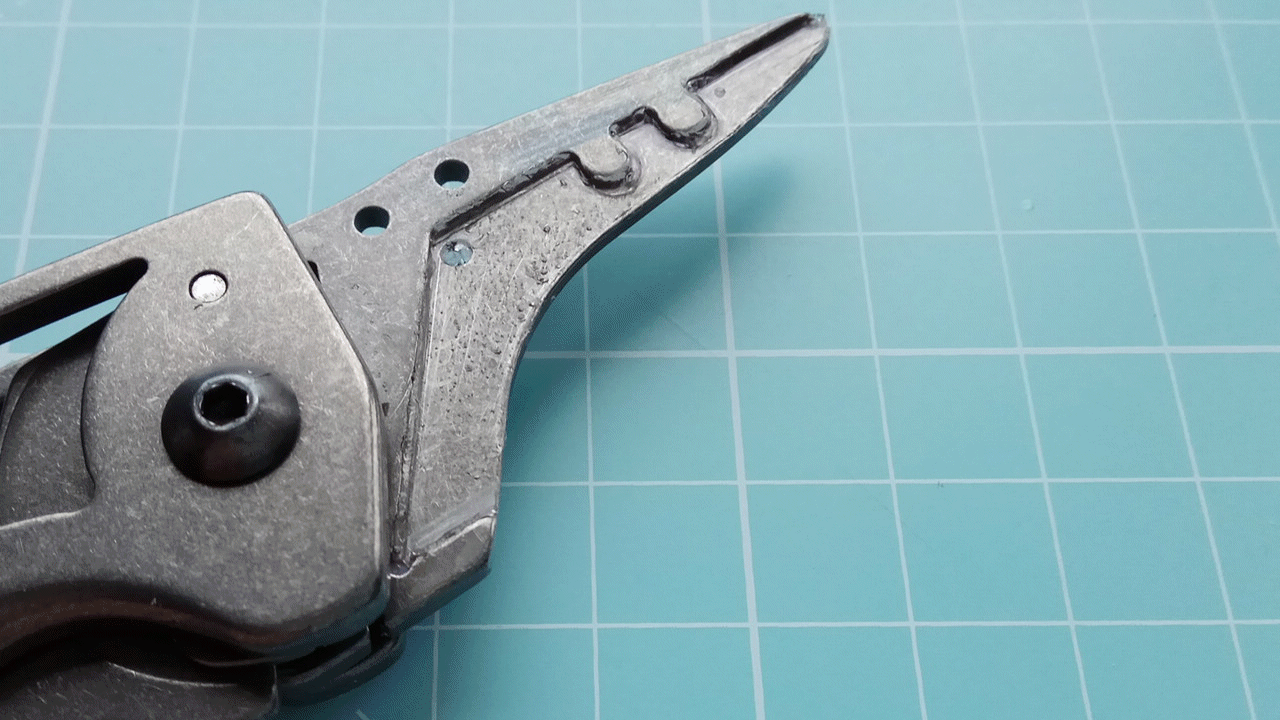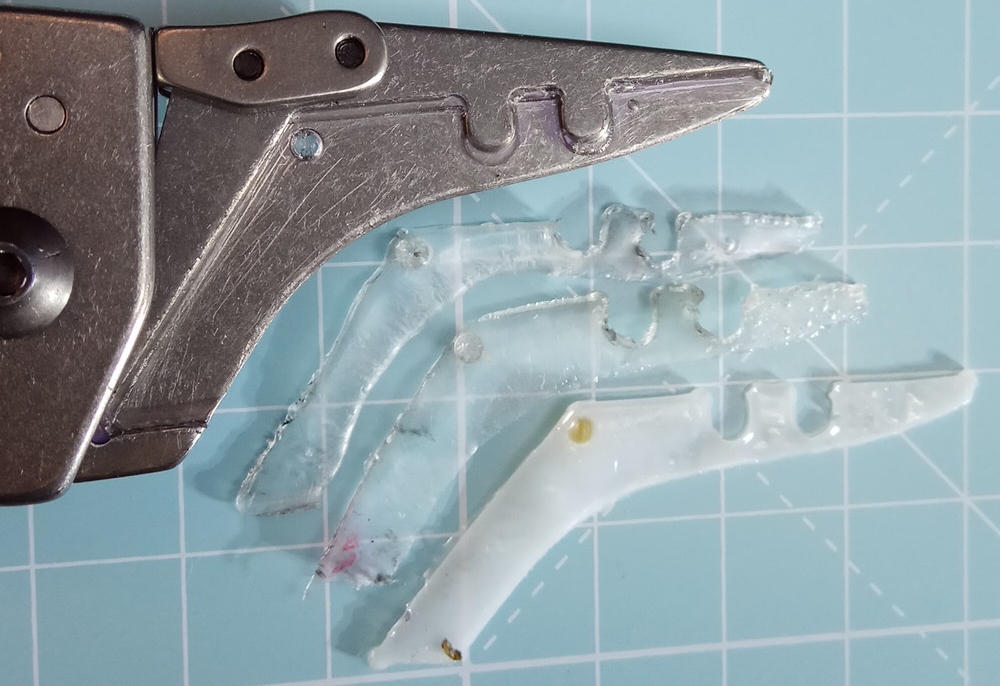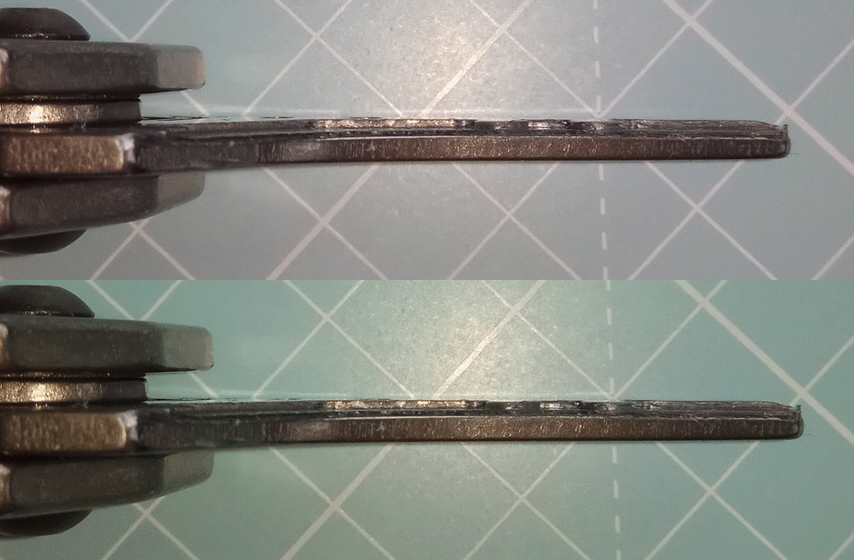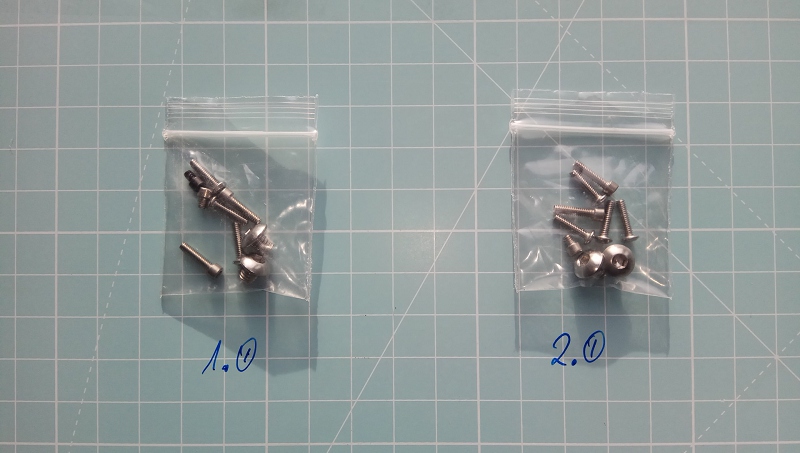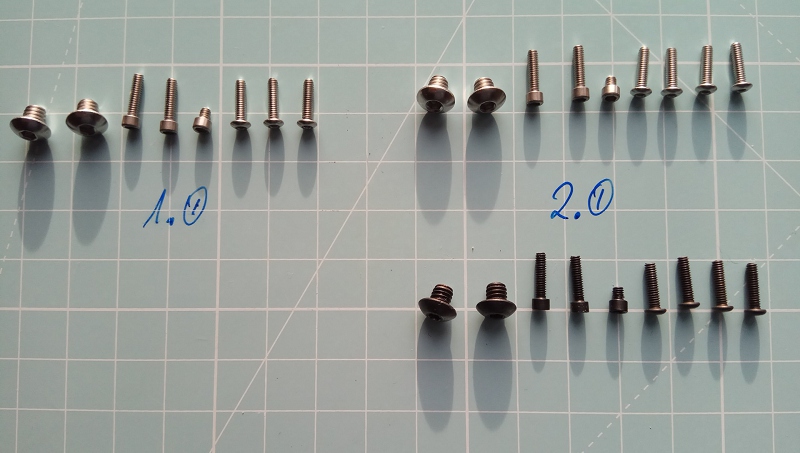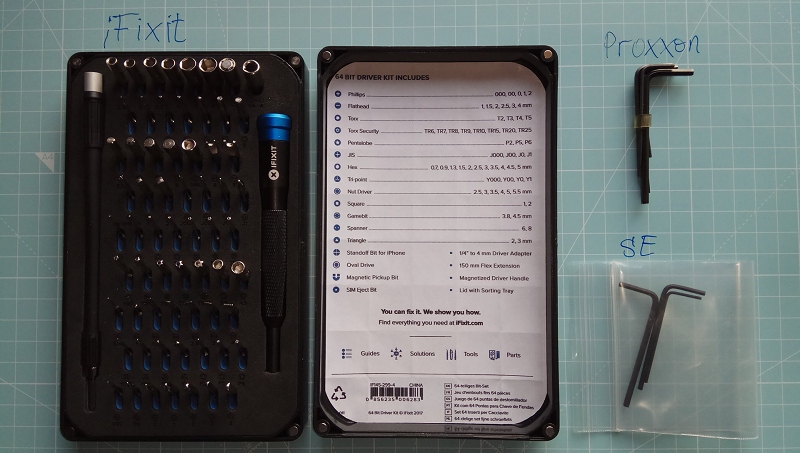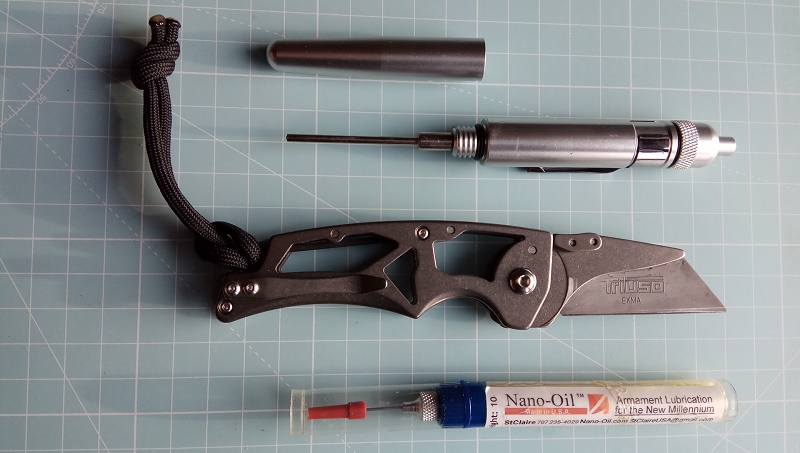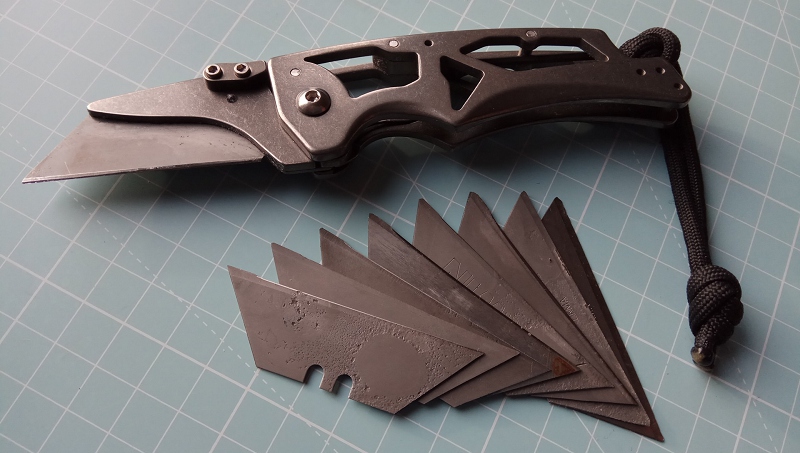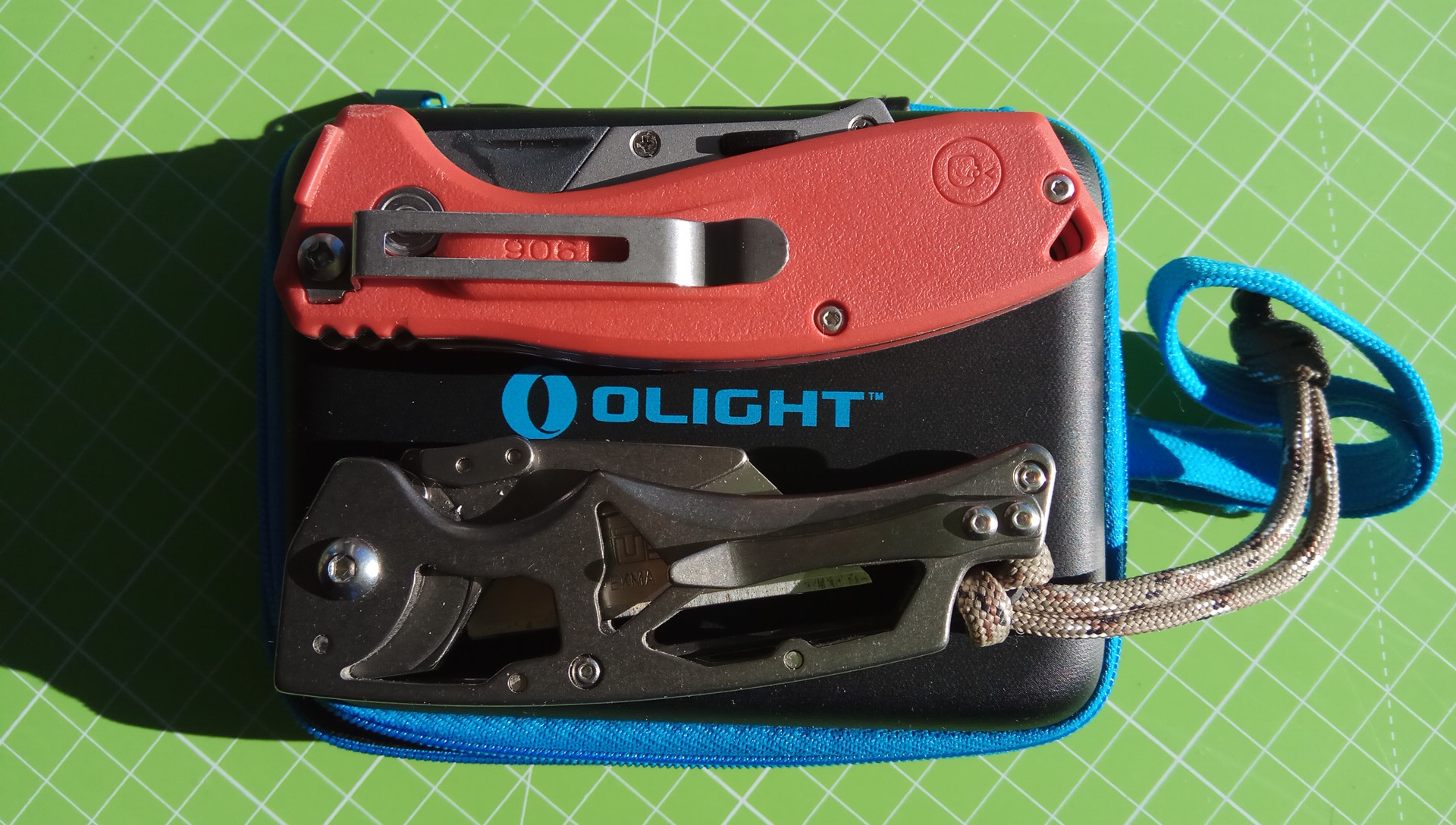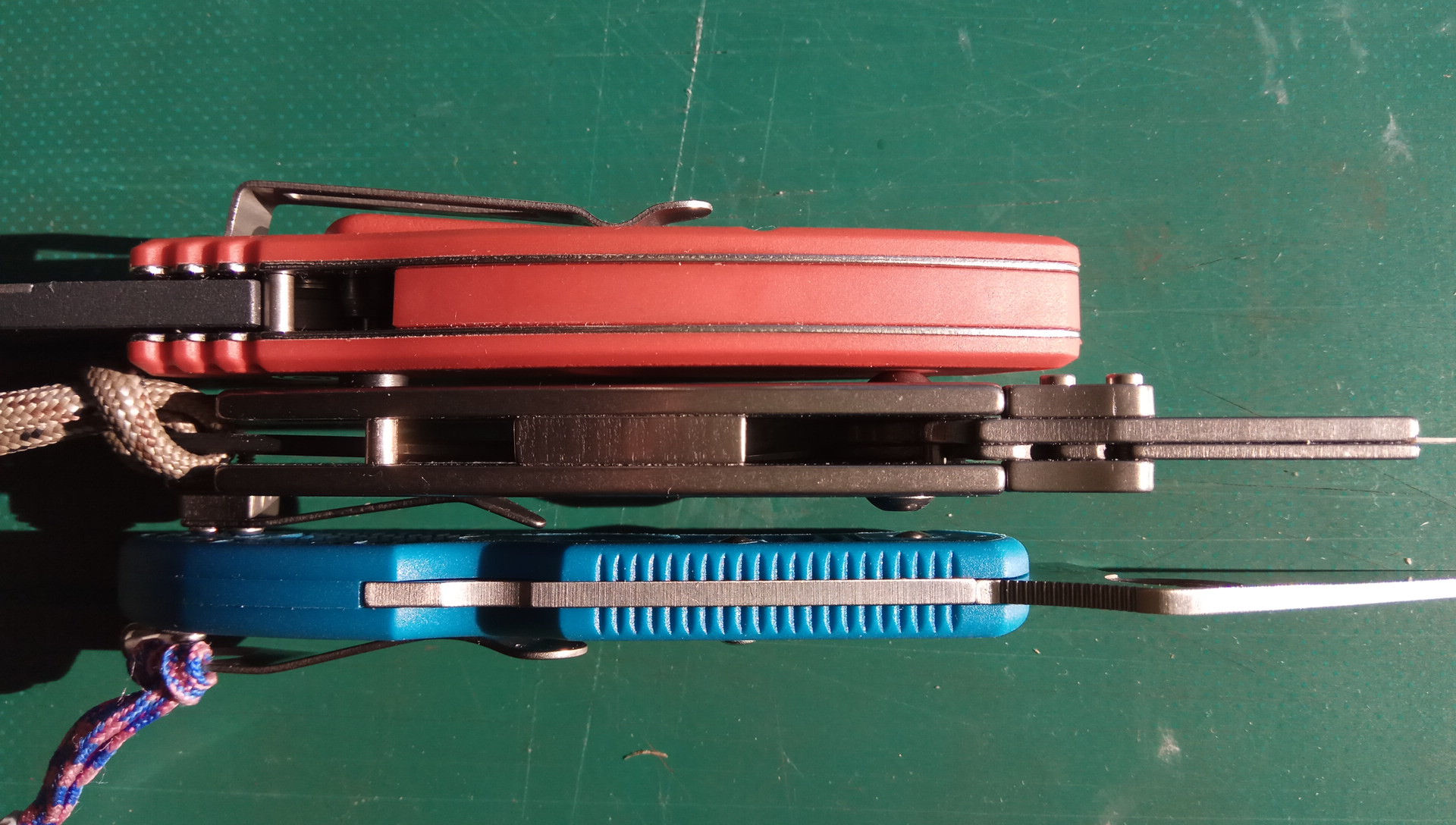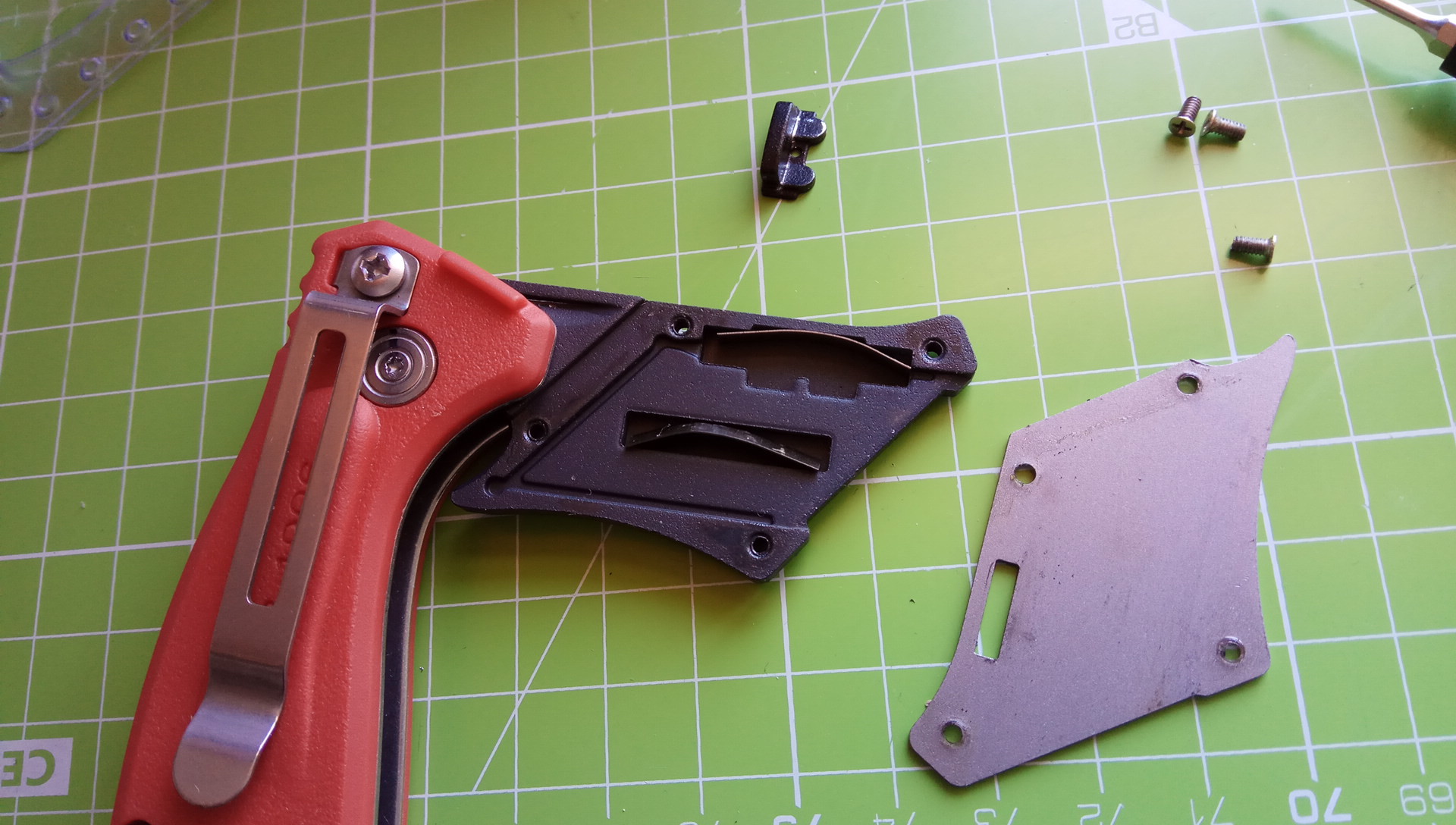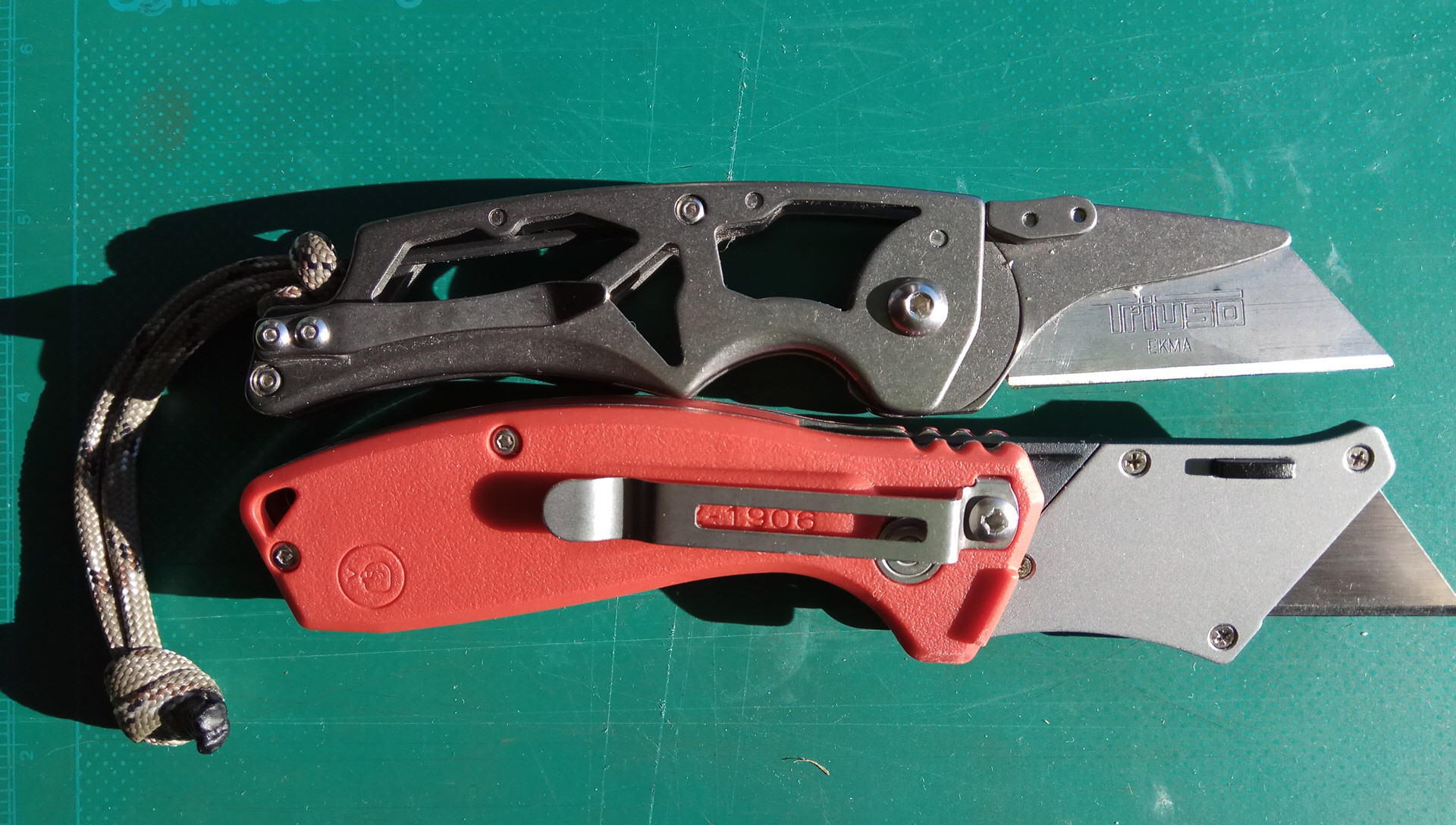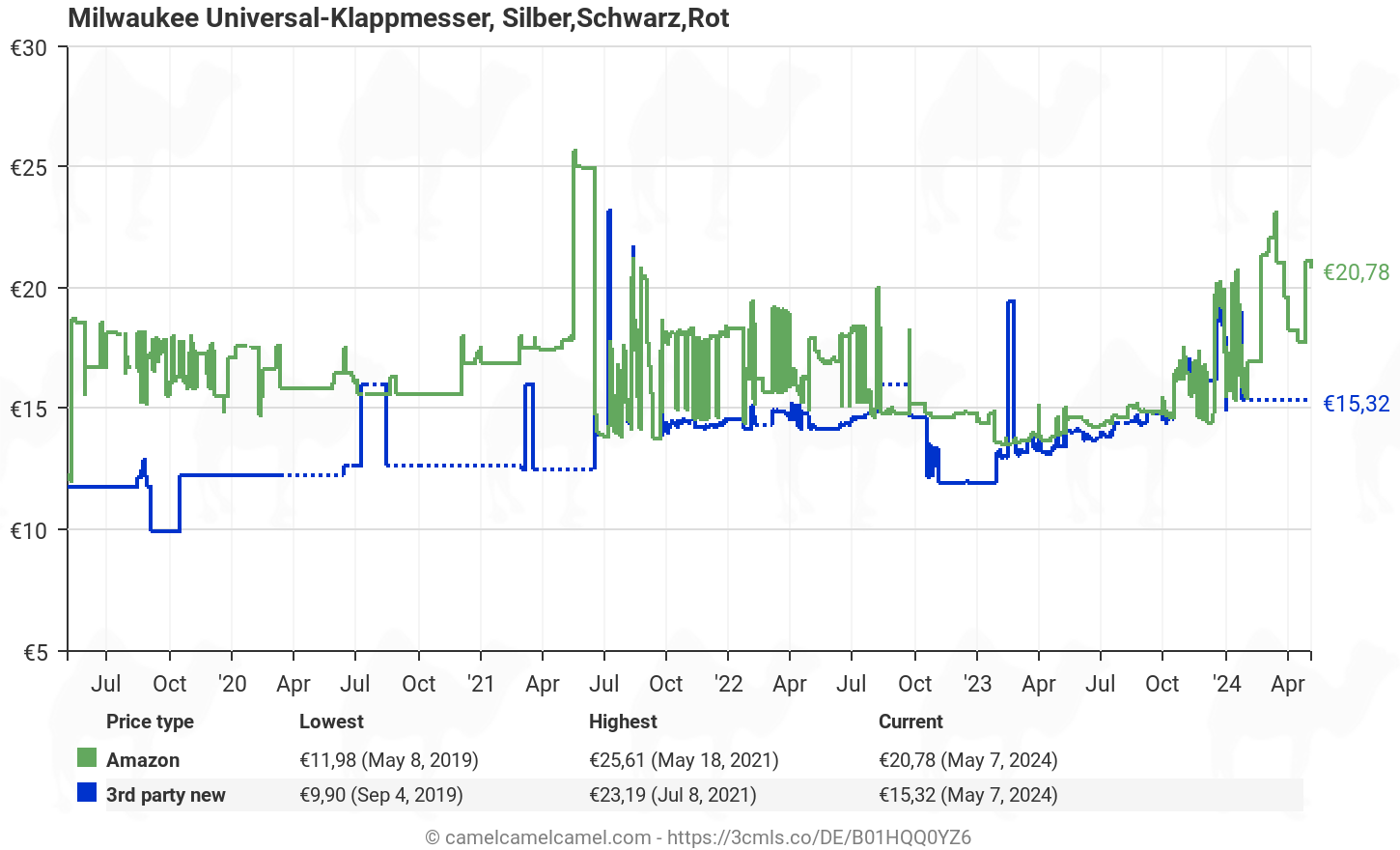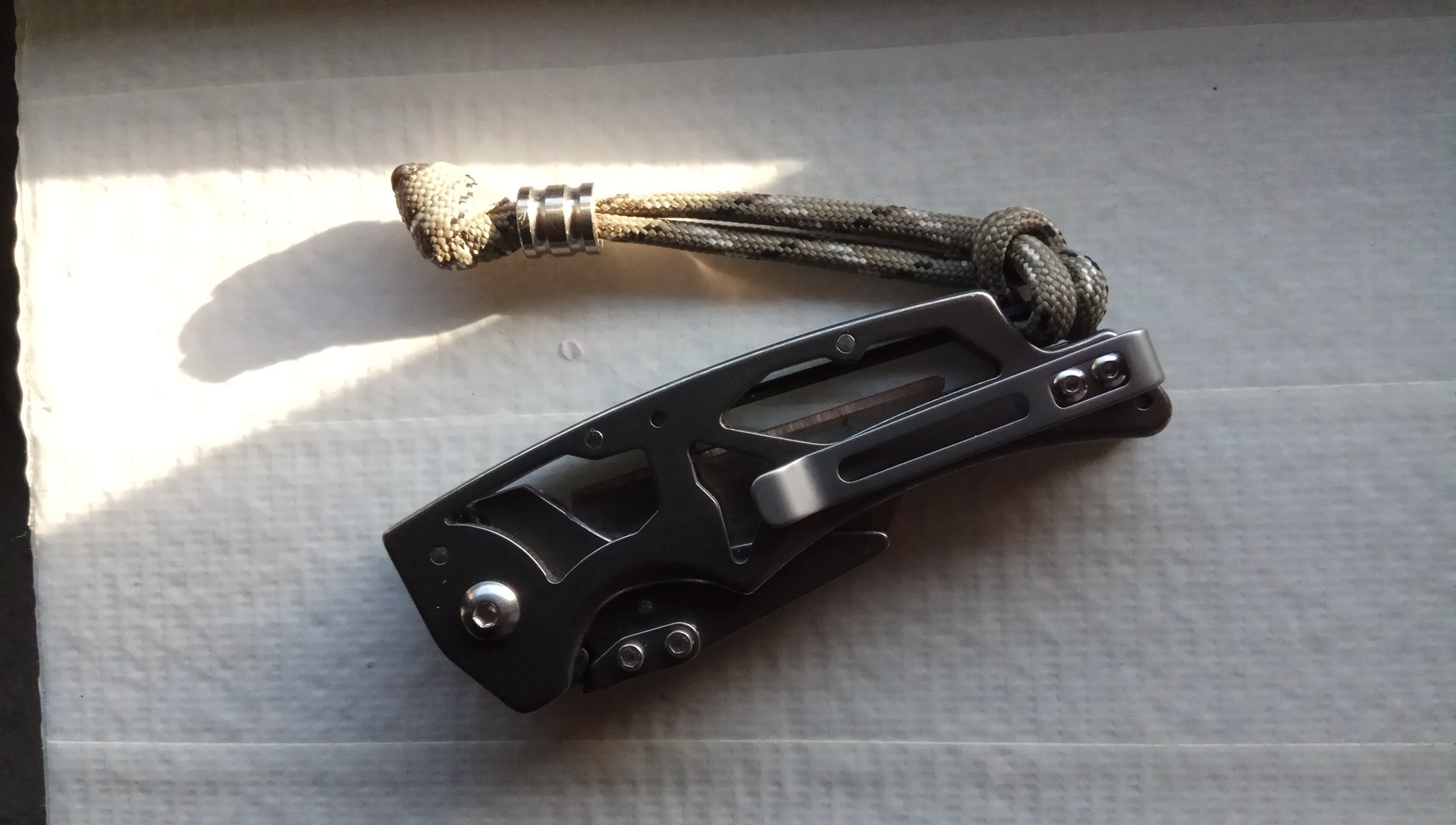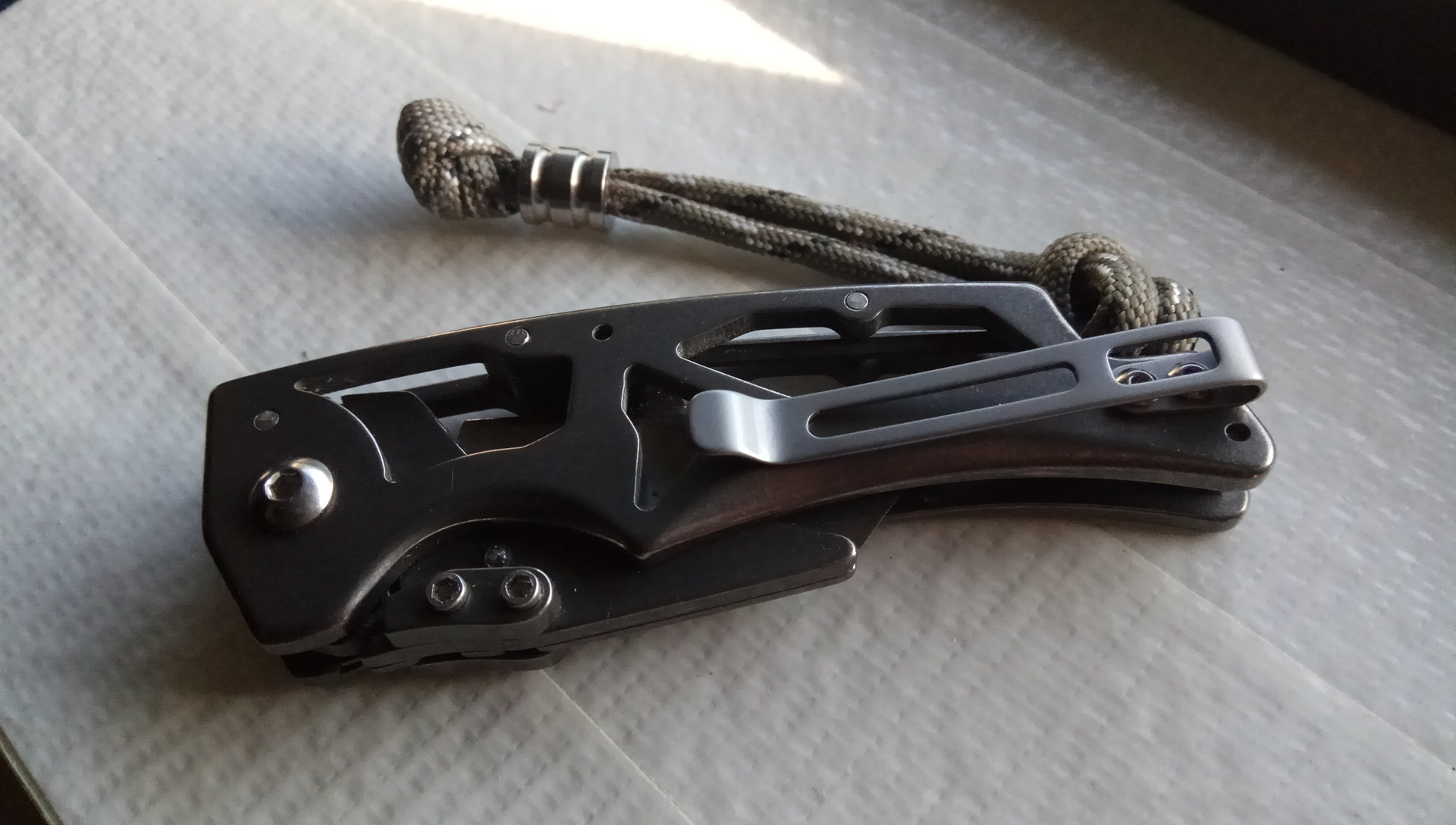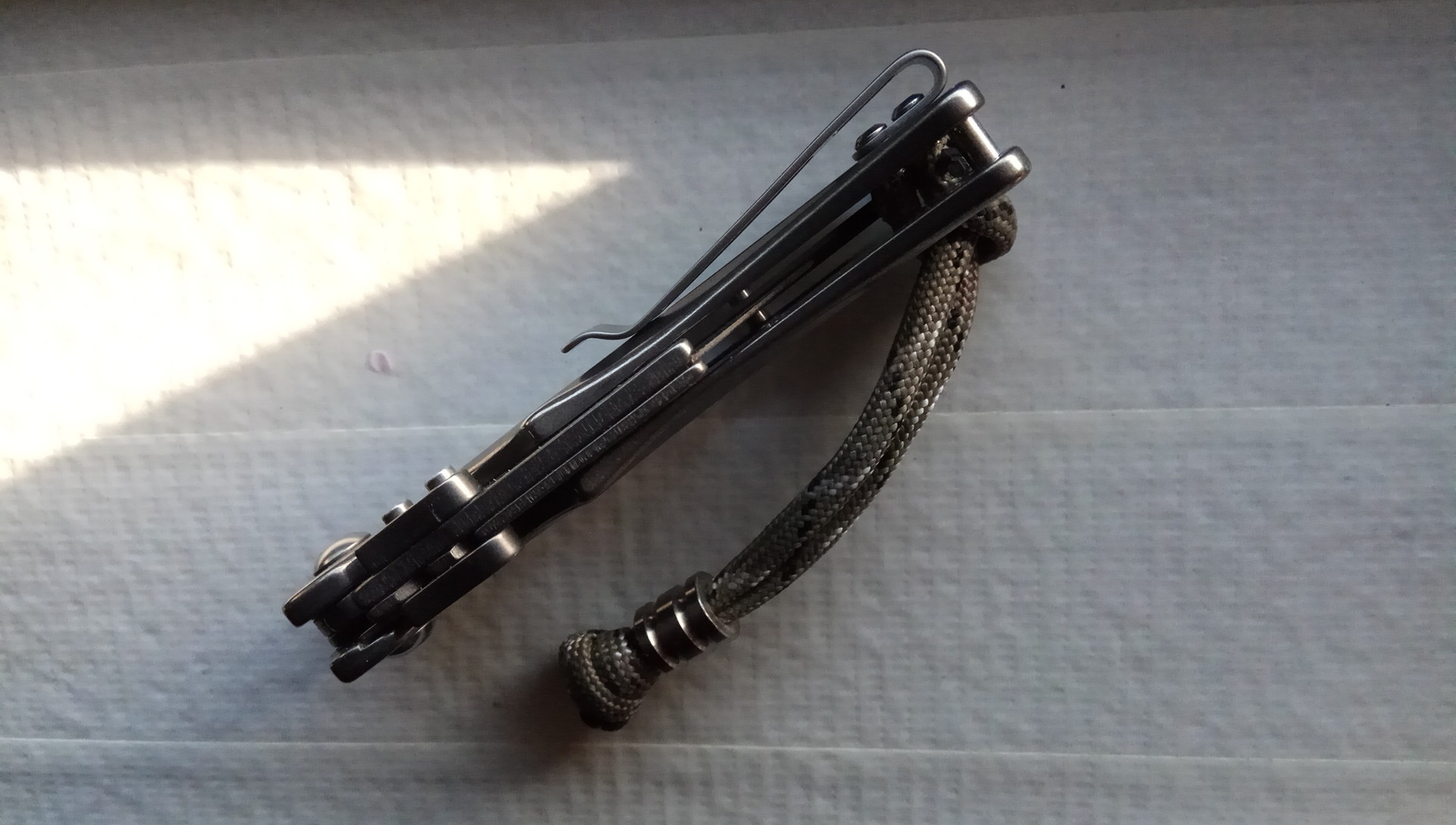(skip to Summary if tl;dr)
Introduction.
I always had serious interest in buying "the best" utility knife (snap-off or trapezoidal blade, retractable or folding make, I didn't mind!), i.e. one single model which was to tick all the right boxes, not only cut all my boxes pun intended. With my snobbish attitude not letting me carry a rebranded tool of a trading company and with Stanley being the #1 traditional name and original maker in the business, back then I believed I had chosen the best product from their catalog; the Stanley Interlock, an ingenious simple model with retractable lockable snap-off blade, did tick two boxes, namely metal construction and zero(!) blade play. In practice, however, the locking mechanism did not prove sufficiently strong for heavy duty tasks, it could not keep the blade from getting stuck in dense sticky material, e.g. silicone joints. And when the snap-off blade (nominal thickness 0.50mm, true thickness 0.49-0.51mm) failed on me repeatedly, breaking off crosswise due to minimal lateral force or torque, I started to realize that my quest wasn't over and that my next utility knife had to have a stronger blade, a trapezoidal blade (nominal thickness 0.60mm, true thickness 0.60-0.62mm). In recent years nicely built folding utility knives (designed and) made in China and meanwhile mass-distributed by Western tool trading companies, have become popular among the crowds, probably because of the very good value, compact size, attractive looks. Or say, unused they looked attractive! After some use, drops, wear'n tear, they start looking cheap and function only as tool anymore. Me, on the other hand, I was willing to spend more than the typical 10, 15, 20 bucks, as long as the product was an EDC-wearable, had superior quality, and I could become a proud owner; the more I spend, the prouder I am of what's in my pants!
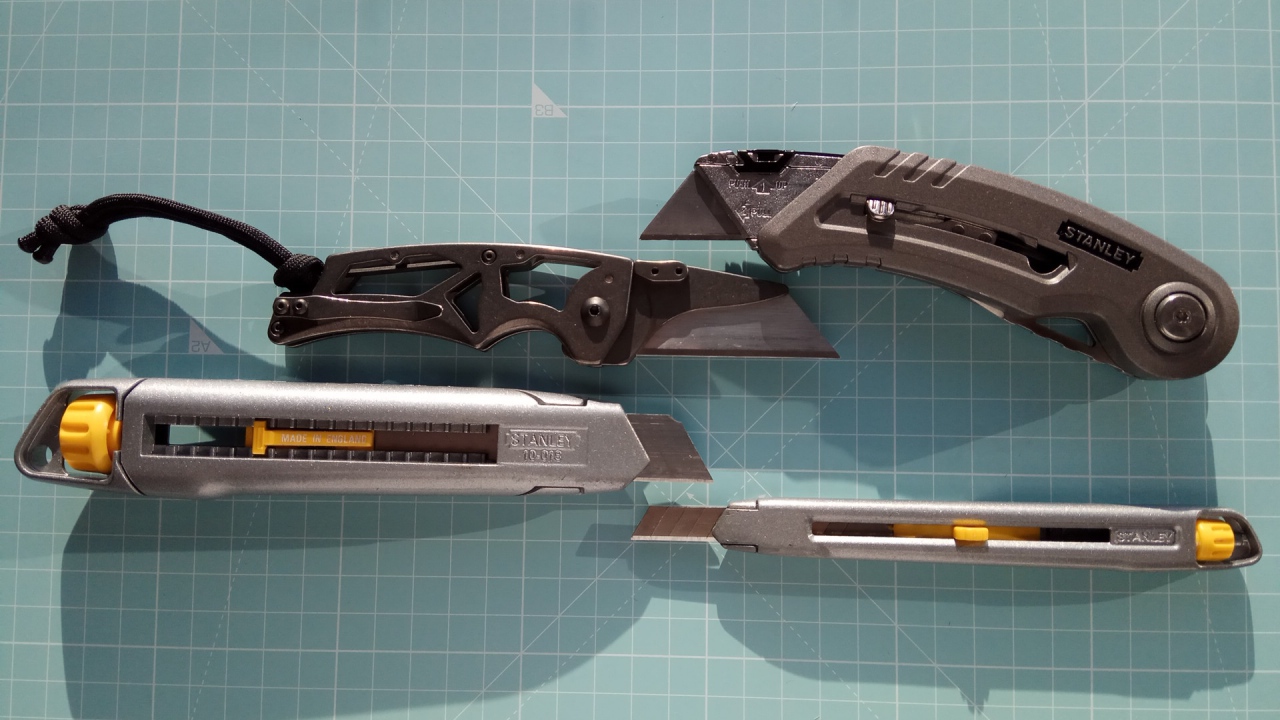
If it were for the tool functionality only, then I would not have looked any further than my bulky Stanley Quickslide Sport gen2, the heavy Milwaukee Fastback 190X (X=gen1/2/3), or the functional Gerber EAB/EAB Lite, which are nicely iterated brandname tools. But they are imho just that. Tools, and with no chance of becoming a substitute for my EDC knife, the Spyderco PM2: the Quickslide being too bulky, the Fastback too heavy, the EAB Lite too ..erh.. "cheap" (said the snob ). In my recent more ambitious search of an all-round satisfying utility knife I eventually came across the Utilizer, a 160-190US$
). In my recent more ambitious search of an all-round satisfying utility knife I eventually came across the Utilizer, a 160-190US$ custom titanium product released to market two years ago by a U.S. machine shop. The small company designs, manufactures, and sells the product direct. Having spent some 150 bucks on my PM2 and really wanting something like the Utilizer to kick the Spydie off its EDC job, I didn't immediately turn my back on this intriguing premium folding utility knife product. Youtube footage was two years old, showcasing the original model which did not have a secure locking mechanism for the blade holder; in the youtube comments the viewers turned their backs after learning about the Spydie-level retail price and that the knife was lacking a lock. I felt put off too, did some further research on Google and social media (Facebook, Instagram, ..) and learned that in summer 2018 the company had worked on the iterated new version which featured at least two notable improvements: the addition of a titanium liner lock and the addition of a blade set screw! When their webshop offered a bunch of display units (exhibition samples) from Blade Show 2018 as so-called "Pre-handled" units at a 15% discount, I didn't think twice and placed the order. The Utilizer 2.0 ticks all the check boxes, in my book. The search is over, the journey is over, which makes it the perfect time to share.
custom titanium product released to market two years ago by a U.S. machine shop. The small company designs, manufactures, and sells the product direct. Having spent some 150 bucks on my PM2 and really wanting something like the Utilizer to kick the Spydie off its EDC job, I didn't immediately turn my back on this intriguing premium folding utility knife product. Youtube footage was two years old, showcasing the original model which did not have a secure locking mechanism for the blade holder; in the youtube comments the viewers turned their backs after learning about the Spydie-level retail price and that the knife was lacking a lock. I felt put off too, did some further research on Google and social media (Facebook, Instagram, ..) and learned that in summer 2018 the company had worked on the iterated new version which featured at least two notable improvements: the addition of a titanium liner lock and the addition of a blade set screw! When their webshop offered a bunch of display units (exhibition samples) from Blade Show 2018 as so-called "Pre-handled" units at a 15% discount, I didn't think twice and placed the order. The Utilizer 2.0 ticks all the check boxes, in my book. The search is over, the journey is over, which makes it the perfect time to share.
Shipping / Packaging.
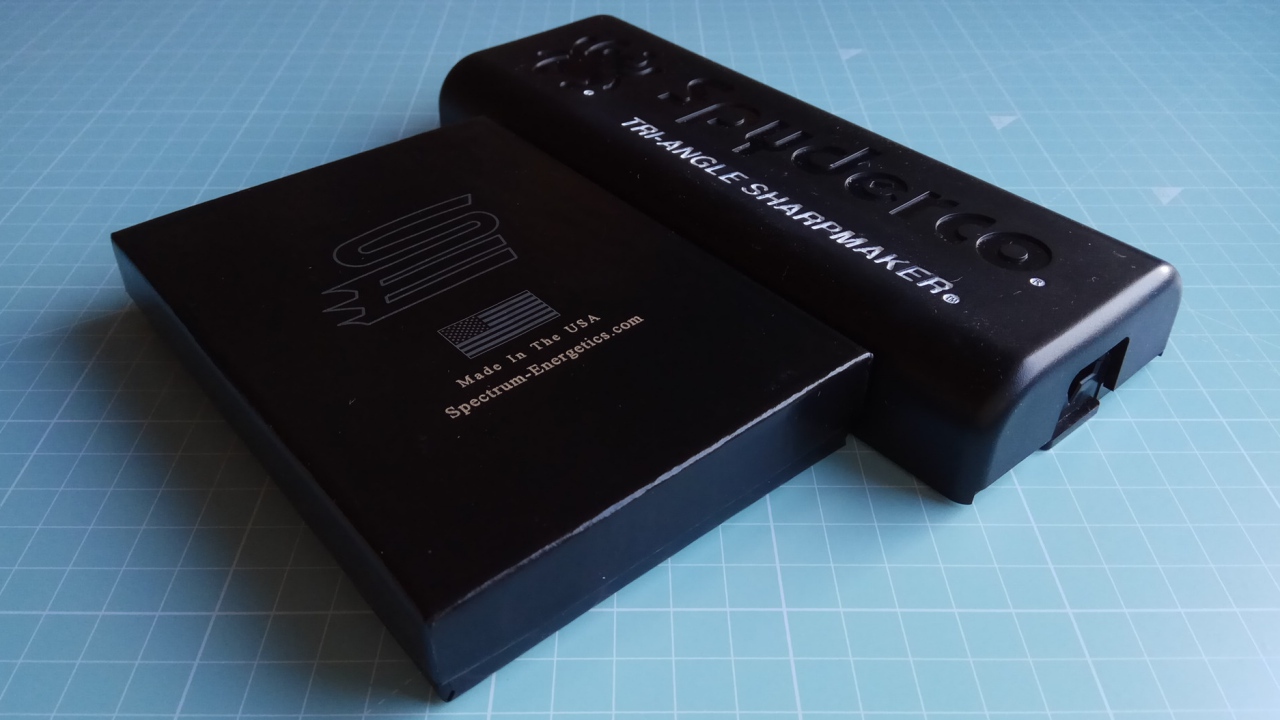
Not much to say here. International shipping cost was surprisingly low, the bubble-padded gray envelope landed in my country in no time and I received it in record time within a week, probably because we are still far from the super busy postal pre-Christmas season. The USPS shipment number showed some tracking information in the destination country too, interesting.
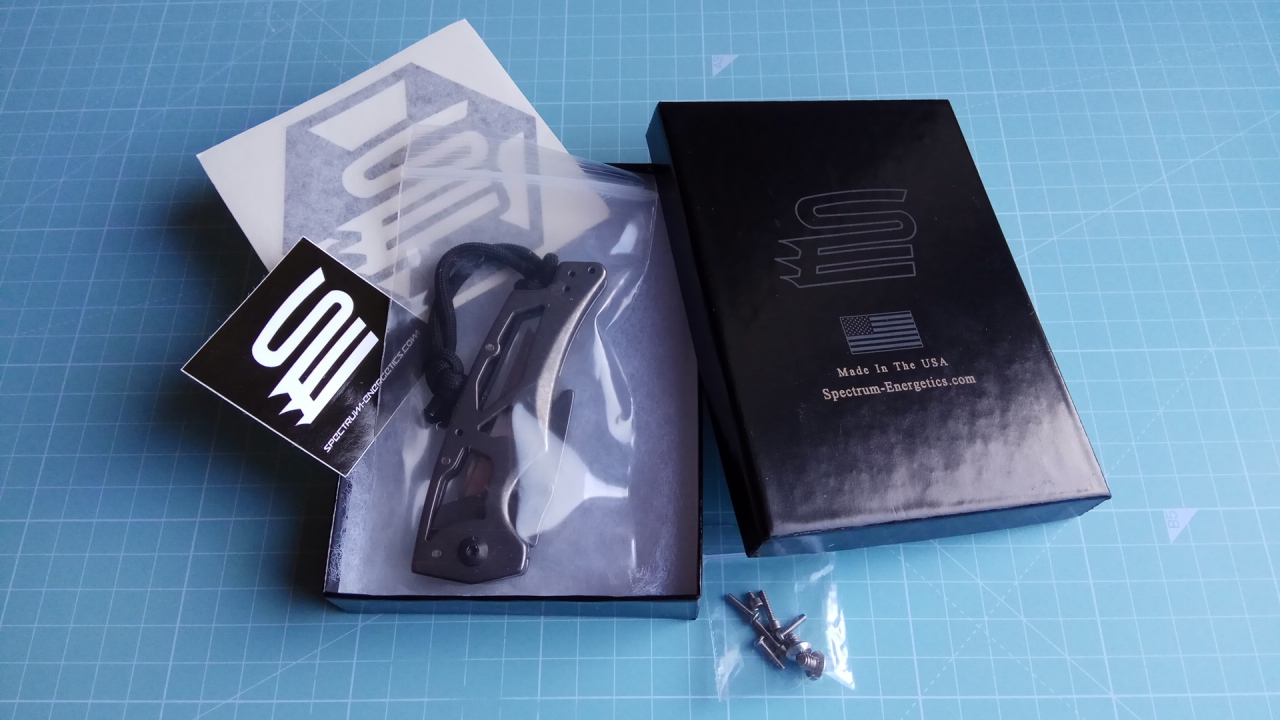
The knife came in a simple black cardboard gift box stating the company name/logo and "Made In The USA" ; inside there were two company name/logo stickers, some padding, the knife, and the extra bag of stainless screws which i had added to my order. There was no printed product information, instruction manual, or similar, nor did I expect any such thing. The company is a machine shop, a custom maker, focusing on the product, manufacturing, and quality, not the 'everything else' like commercialization, marketing and whatnot.
; inside there were two company name/logo stickers, some padding, the knife, and the extra bag of stainless screws which i had added to my order. There was no printed product information, instruction manual, or similar, nor did I expect any such thing. The company is a machine shop, a custom maker, focusing on the product, manufacturing, and quality, not the 'everything else' like commercialization, marketing and whatnot.
Looks / Design / Artistry.
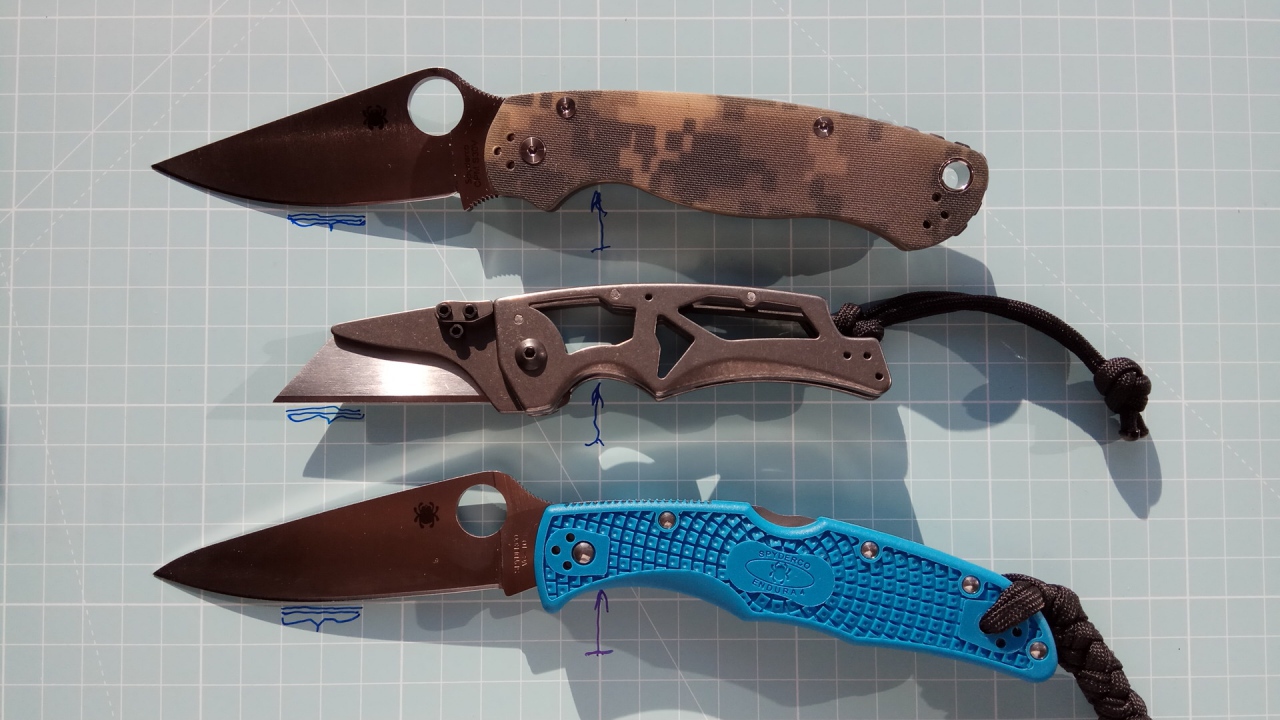
I have a hard time forming an opinion about whether a knife looks harmonic'n beautiful, or not. The Utilizer with solid liners looked so-so in my eyes, being a knife with a short blade section versus much longer handles; the metal ratio of what met my eyes seemed skewed, too much titanium, not enough blade (cf. Spyderco PM3).
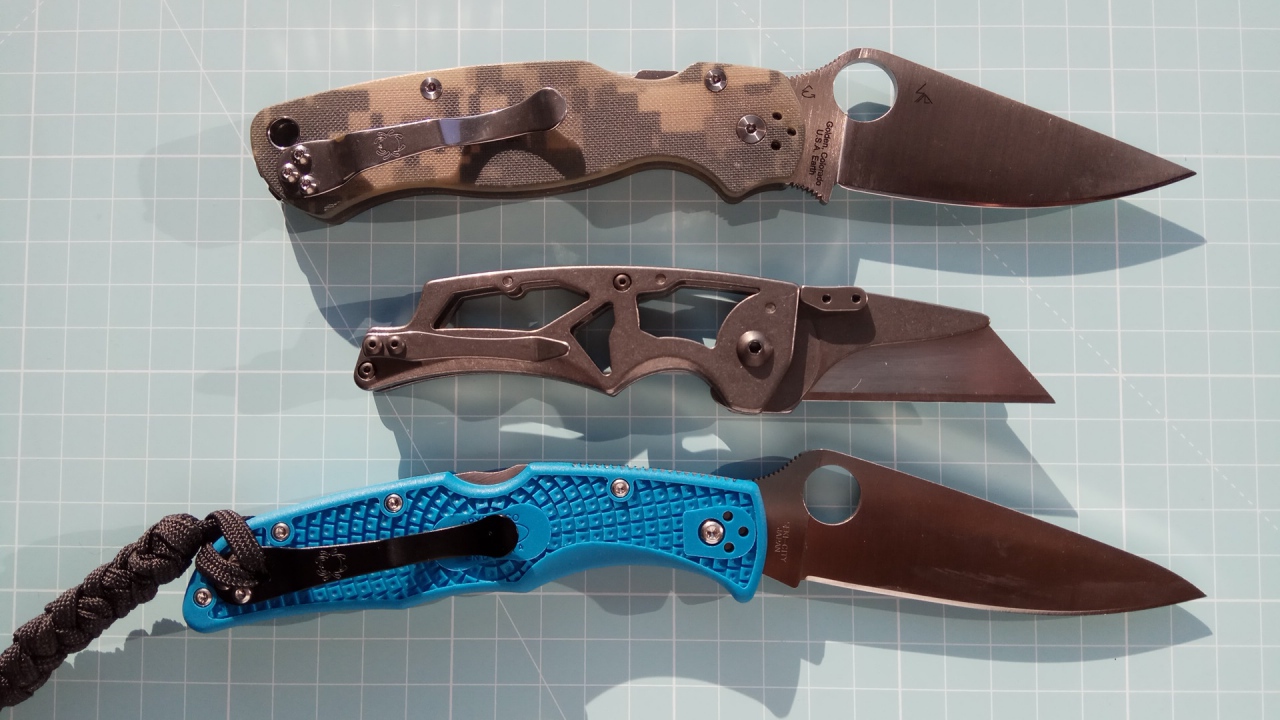
The skeletonization however really did it for me, and the overall looks seem to fall into place now, I honestly dig the result ymmv, both in the fully opened and in the closed positions.
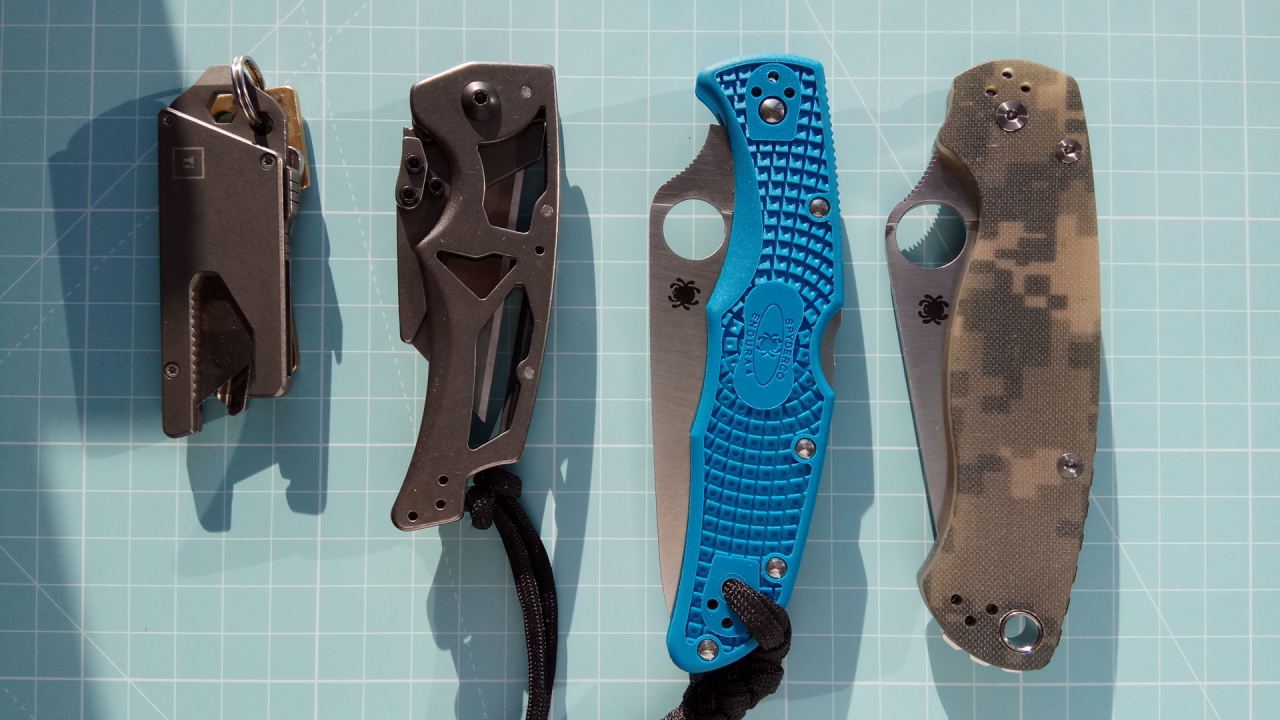
At first I didn't understand why the thumb stud (Thumb-Open) was designed so big, longish, until its triple function became clear to me, acting as a nicely formed comfortable thumb rest during cutting operations…
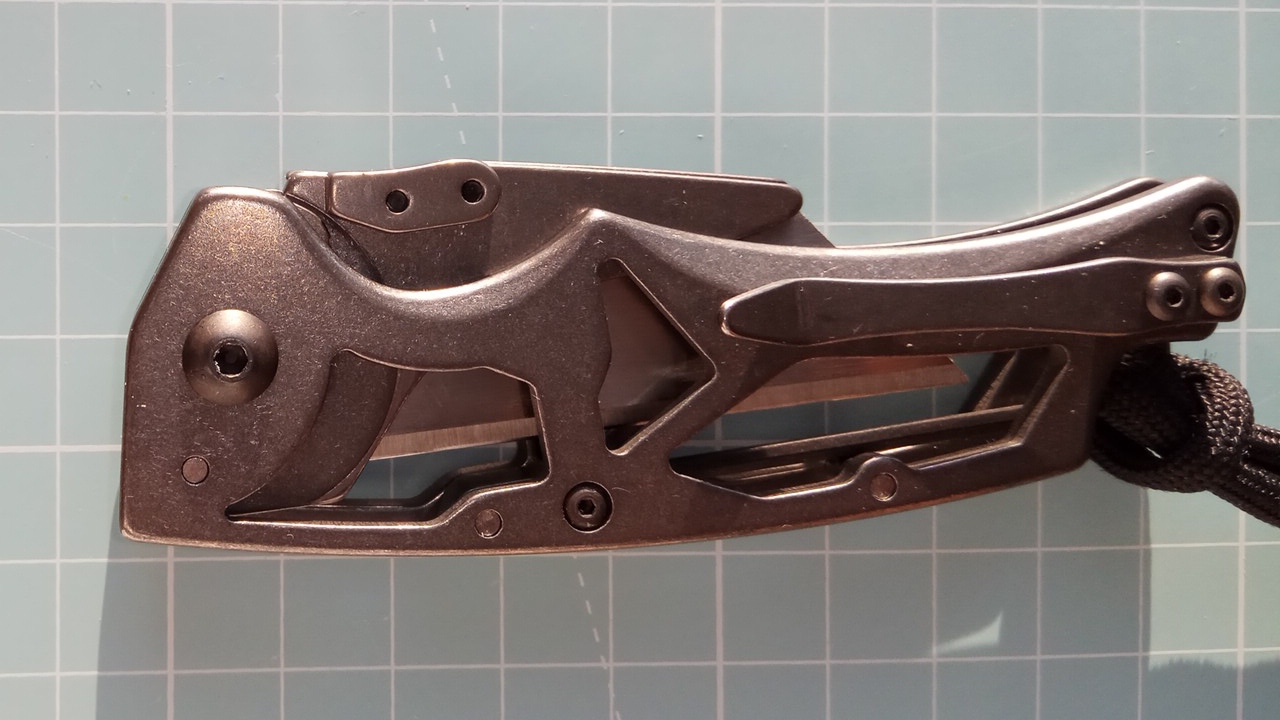
…and also as stopper for the blade holder in the fully opened position:
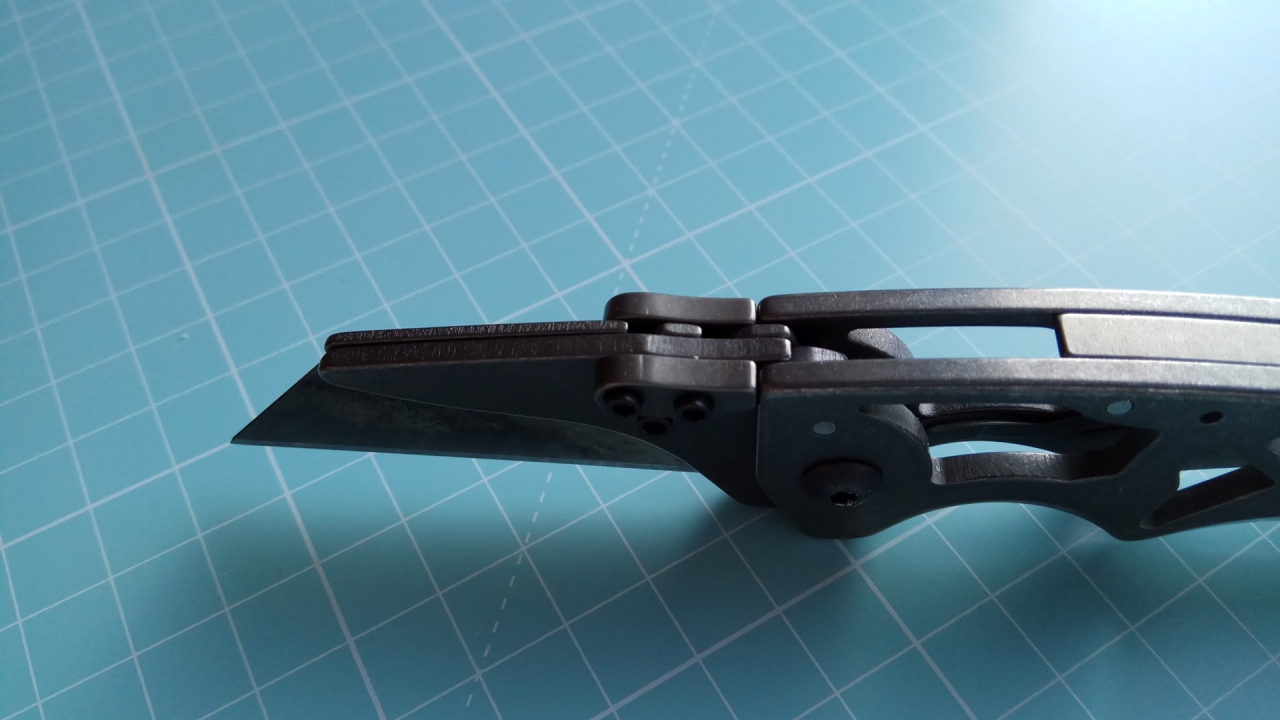
Let's not forget that the color (and partly the material itself) of the four component groups can be customized. I preferred the all titanium material all titanium color look anyway, imho it is the most classy timeless configuration. When I look into my wardrobe at all the colorful T-shirts which I had ever bought for myself, then I could facepalm me all day long. Fashion and personal tastes change. A titanium knife in natural titanium color? Sounds like a safe, reasonable choice to me, risk-free, no harm done.
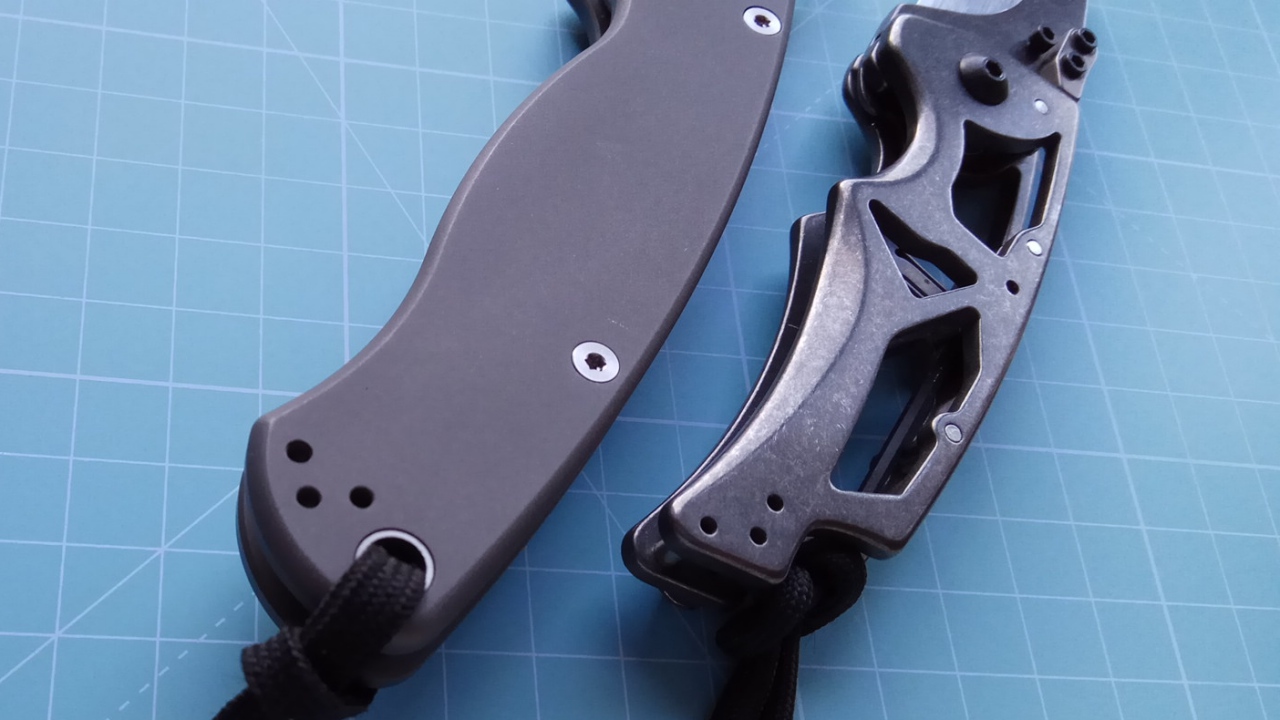
As you can see, the metal surface is smooth, dense, shiny, reflective, and also has a different titanium color than the CN titanium knife on the left which has a matt, porous finish.
Size / Dimensions / Weight.
Most/many folding utility knives come in an all metal construction. But this one comes in titanium (Grade ?), and my unit even in skeletonized titanium.
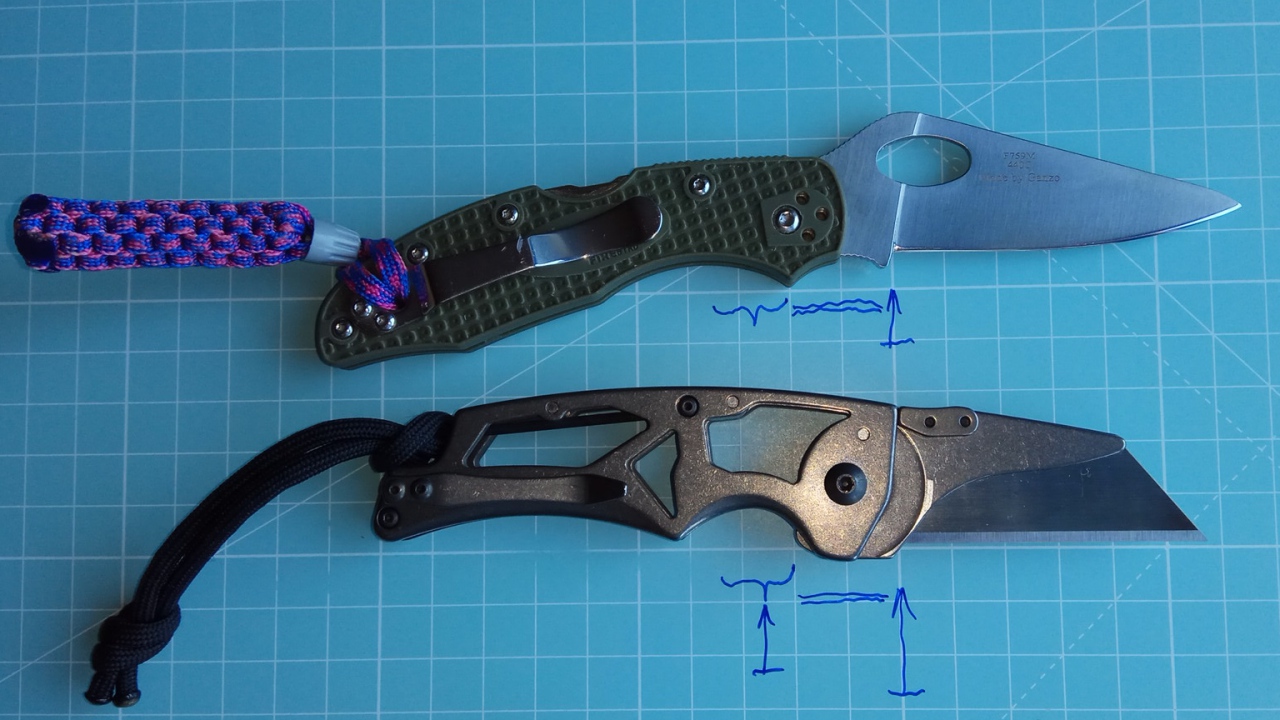
The overall size and weight is similar to a Spyderco Delica 4 FRN (71g) or Byrd Meadowlark 2 FRN (67g). My measurements with installed Stanley blade and pocket clip are 75g w/ (wrench+lanyard) and 71g w/o (wrench+lanyard).
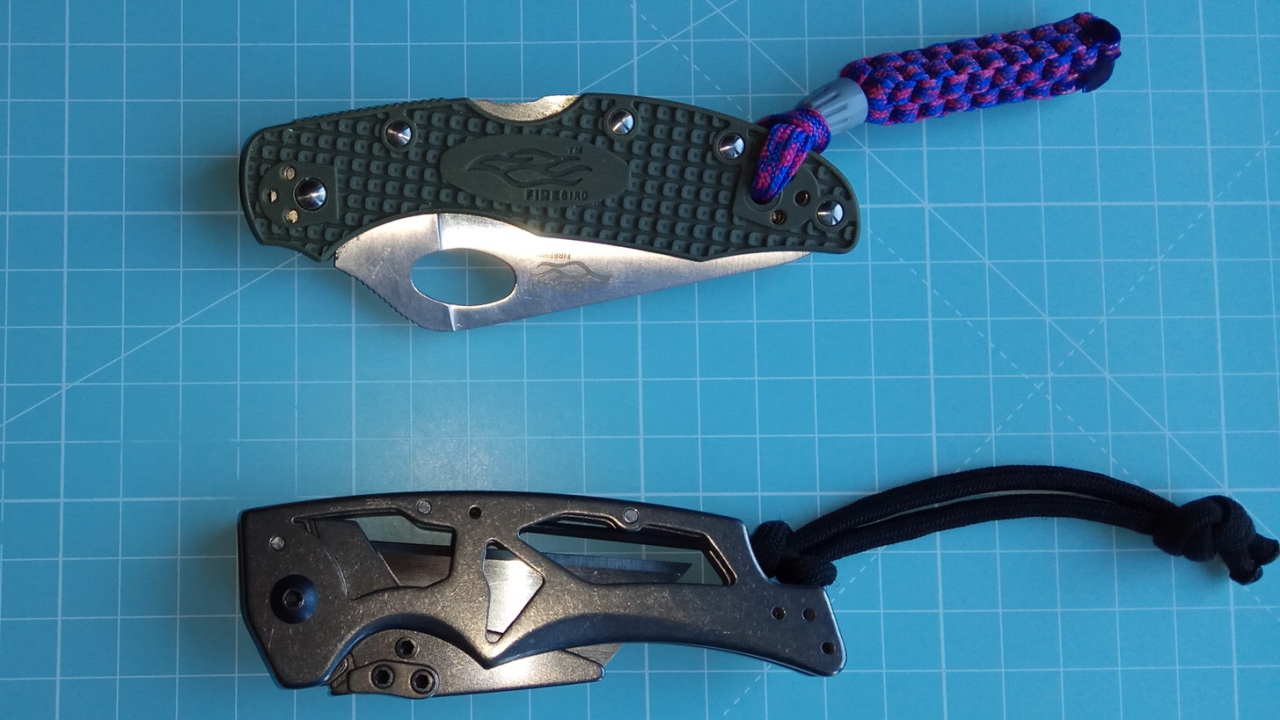
Maybe some other owner can chime in and share the weight of her/his unit, e.g. with flipper construction and solid titanium scales, thanks.
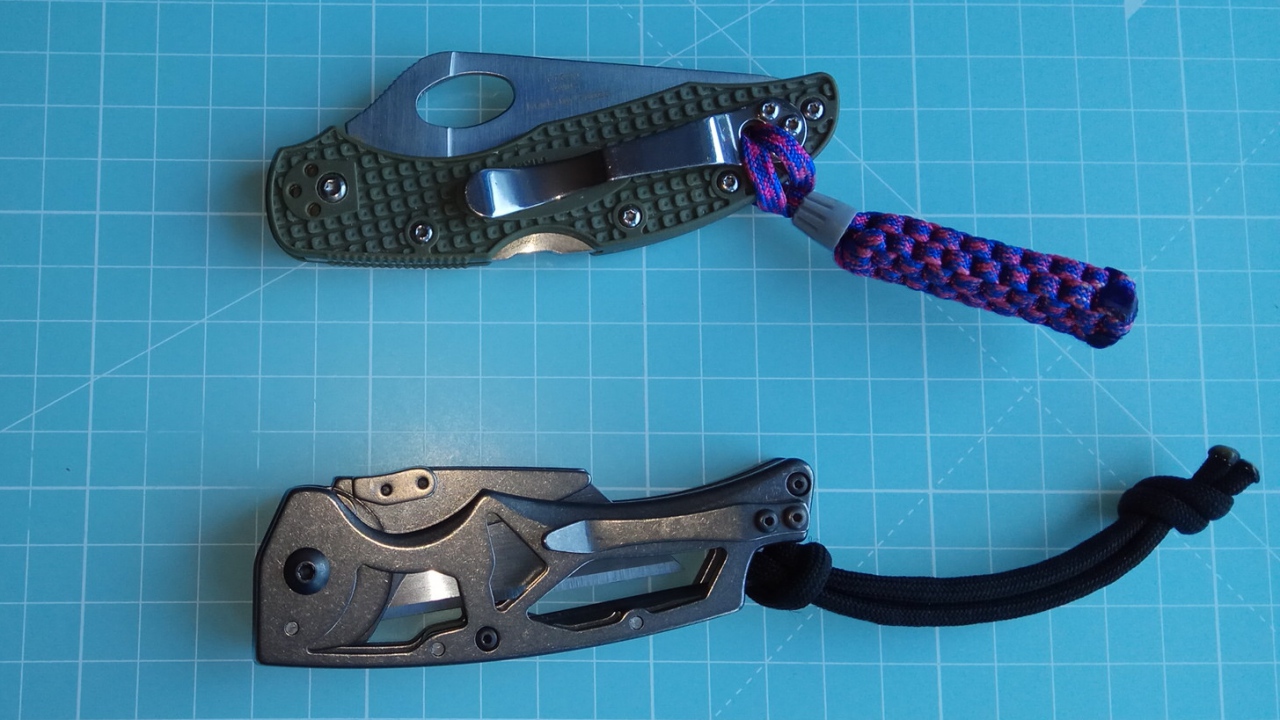
Ignoring the pocket clip, the handle has a total thickness of 11.5mm, which is similar to the PM2 handle (11.6mm).
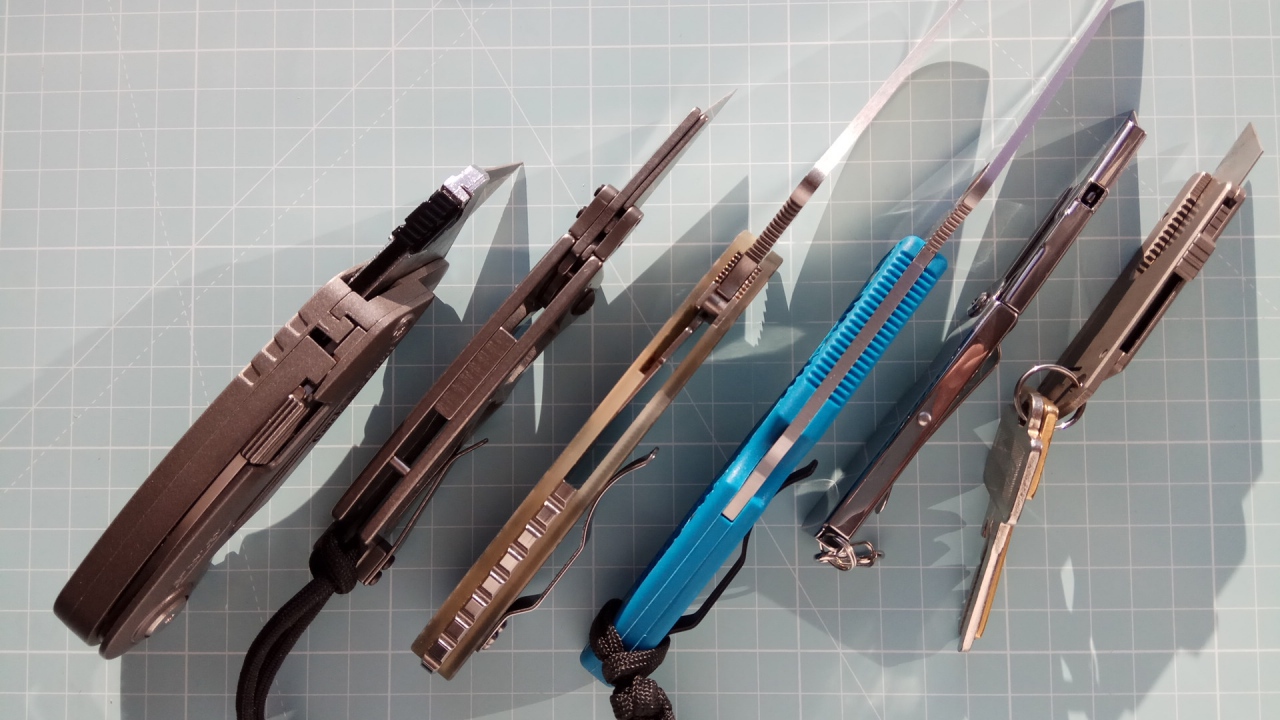
The max width is 33.1mm, the length is 95.0mm in the closed position.
Pocket clip.

For tip-up carry, left or right side, the shallow ramping lets the firm flexible clip slide, almost "glide", bump-free over the pocket brim to the deep-carry-like end position where the knife is held nice securely.
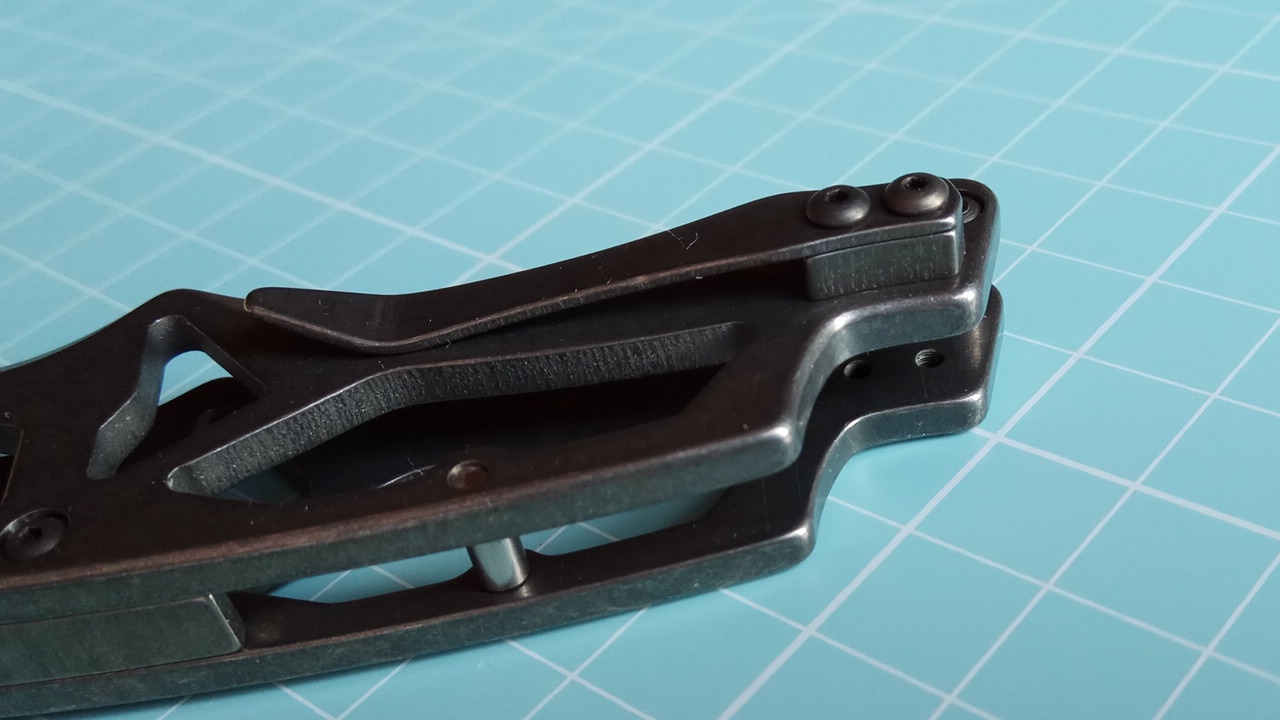
The two smooth metal contacting spots generate little friction, which should translate to less tear on the fabric over time than, for example, a metal<>FRN or a metal<>G10 interface.
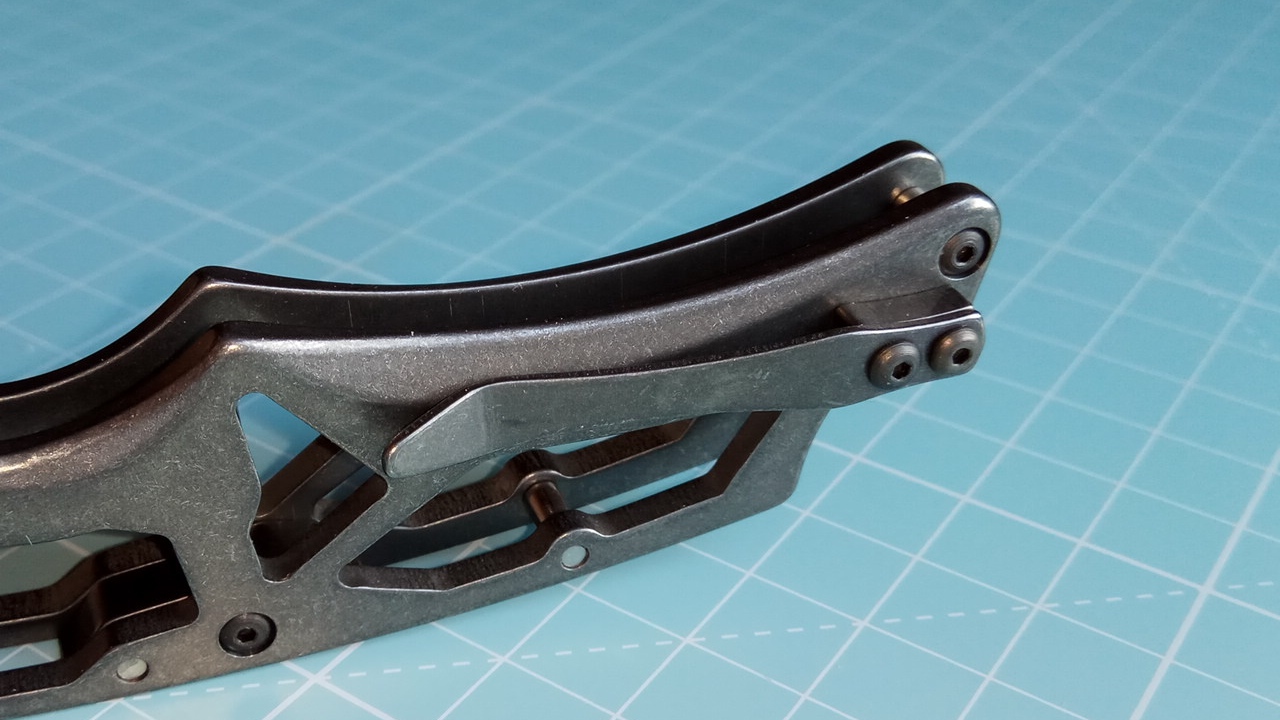
Time will tell how pocket-friendly this cute stylish titanium clip performs in the long run. I dig the size, looks, secure mounting, and functionality of the clip.
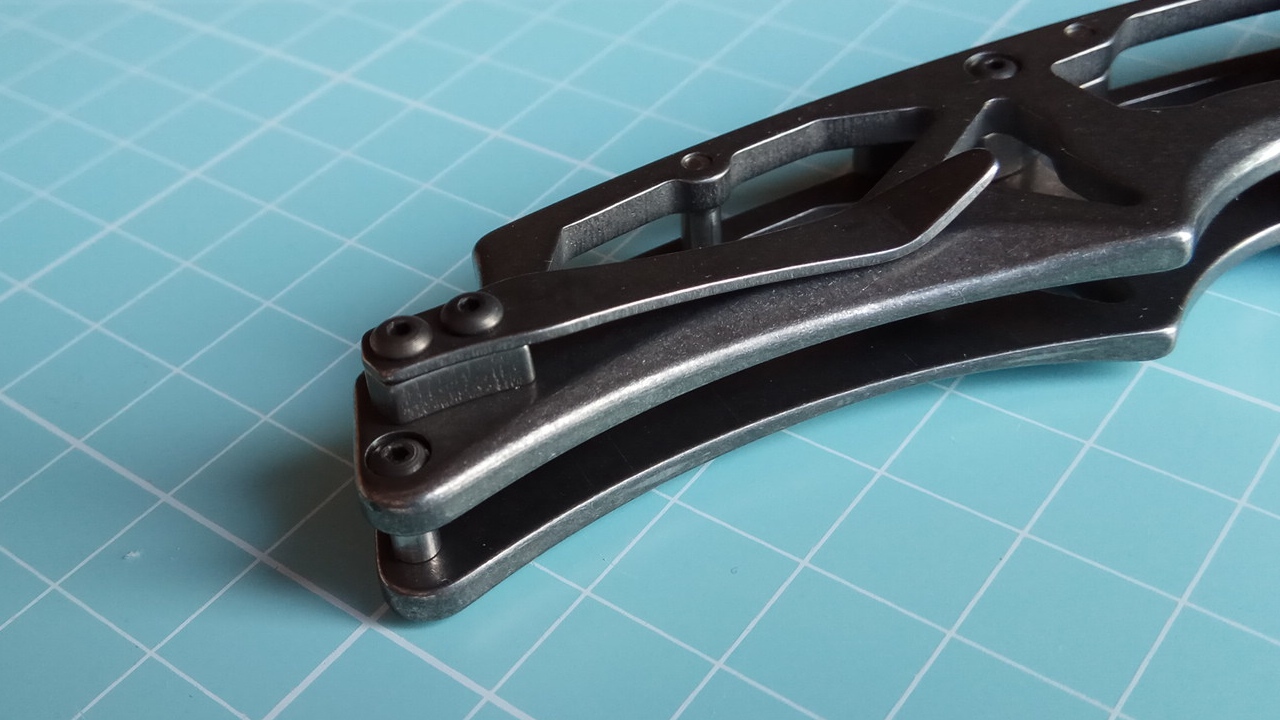
There would have been space on the handle to design it longer but there was obviously no need for it (re functionality, aesthetic proportionalism).
Introduction.
I always had serious interest in buying "the best" utility knife (snap-off or trapezoidal blade, retractable or folding make, I didn't mind!), i.e. one single model which was to tick all the right boxes, not only cut all my boxes pun intended. With my snobbish attitude not letting me carry a rebranded tool of a trading company and with Stanley being the #1 traditional name and original maker in the business, back then I believed I had chosen the best product from their catalog; the Stanley Interlock, an ingenious simple model with retractable lockable snap-off blade, did tick two boxes, namely metal construction and zero(!) blade play. In practice, however, the locking mechanism did not prove sufficiently strong for heavy duty tasks, it could not keep the blade from getting stuck in dense sticky material, e.g. silicone joints. And when the snap-off blade (nominal thickness 0.50mm, true thickness 0.49-0.51mm) failed on me repeatedly, breaking off crosswise due to minimal lateral force or torque, I started to realize that my quest wasn't over and that my next utility knife had to have a stronger blade, a trapezoidal blade (nominal thickness 0.60mm, true thickness 0.60-0.62mm). In recent years nicely built folding utility knives (designed and) made in China and meanwhile mass-distributed by Western tool trading companies, have become popular among the crowds, probably because of the very good value, compact size, attractive looks. Or say, unused they looked attractive! After some use, drops, wear'n tear, they start looking cheap and function only as tool anymore. Me, on the other hand, I was willing to spend more than the typical 10, 15, 20 bucks, as long as the product was an EDC-wearable, had superior quality, and I could become a proud owner; the more I spend, the prouder I am of what's in my pants!

If it were for the tool functionality only, then I would not have looked any further than my bulky Stanley Quickslide Sport gen2, the heavy Milwaukee Fastback 190X (X=gen1/2/3), or the functional Gerber EAB/EAB Lite, which are nicely iterated brandname tools. But they are imho just that. Tools, and with no chance of becoming a substitute for my EDC knife, the Spyderco PM2: the Quickslide being too bulky, the Fastback too heavy, the EAB Lite too ..erh.. "cheap" (said the snob
Shipping / Packaging.

Not much to say here. International shipping cost was surprisingly low, the bubble-padded gray envelope landed in my country in no time and I received it in record time within a week, probably because we are still far from the super busy postal pre-Christmas season. The USPS shipment number showed some tracking information in the destination country too, interesting.

The knife came in a simple black cardboard gift box stating the company name/logo and "Made In The USA"
 ; inside there were two company name/logo stickers, some padding, the knife, and the extra bag of stainless screws which i had added to my order. There was no printed product information, instruction manual, or similar, nor did I expect any such thing. The company is a machine shop, a custom maker, focusing on the product, manufacturing, and quality, not the 'everything else' like commercialization, marketing and whatnot.
; inside there were two company name/logo stickers, some padding, the knife, and the extra bag of stainless screws which i had added to my order. There was no printed product information, instruction manual, or similar, nor did I expect any such thing. The company is a machine shop, a custom maker, focusing on the product, manufacturing, and quality, not the 'everything else' like commercialization, marketing and whatnot.Looks / Design / Artistry.

I have a hard time forming an opinion about whether a knife looks harmonic'n beautiful, or not. The Utilizer with solid liners looked so-so in my eyes, being a knife with a short blade section versus much longer handles; the metal ratio of what met my eyes seemed skewed, too much titanium, not enough blade (cf. Spyderco PM3).

The skeletonization however really did it for me, and the overall looks seem to fall into place now, I honestly dig the result ymmv, both in the fully opened and in the closed positions.

At first I didn't understand why the thumb stud (Thumb-Open) was designed so big, longish, until its triple function became clear to me, acting as a nicely formed comfortable thumb rest during cutting operations…

…and also as stopper for the blade holder in the fully opened position:

Let's not forget that the color (and partly the material itself) of the four component groups can be customized. I preferred the all titanium material all titanium color look anyway, imho it is the most classy timeless configuration. When I look into my wardrobe at all the colorful T-shirts which I had ever bought for myself, then I could facepalm me all day long. Fashion and personal tastes change. A titanium knife in natural titanium color? Sounds like a safe, reasonable choice to me, risk-free, no harm done.

As you can see, the metal surface is smooth, dense, shiny, reflective, and also has a different titanium color than the CN titanium knife on the left which has a matt, porous finish.
Size / Dimensions / Weight.
Most/many folding utility knives come in an all metal construction. But this one comes in titanium (Grade ?), and my unit even in skeletonized titanium.

The overall size and weight is similar to a Spyderco Delica 4 FRN (71g) or Byrd Meadowlark 2 FRN (67g). My measurements with installed Stanley blade and pocket clip are 75g w/ (wrench+lanyard) and 71g w/o (wrench+lanyard).

Maybe some other owner can chime in and share the weight of her/his unit, e.g. with flipper construction and solid titanium scales, thanks.

Ignoring the pocket clip, the handle has a total thickness of 11.5mm, which is similar to the PM2 handle (11.6mm).

The max width is 33.1mm, the length is 95.0mm in the closed position.
Pocket clip.

For tip-up carry, left or right side, the shallow ramping lets the firm flexible clip slide, almost "glide", bump-free over the pocket brim to the deep-carry-like end position where the knife is held nice securely.

The two smooth metal contacting spots generate little friction, which should translate to less tear on the fabric over time than, for example, a metal<>FRN or a metal<>G10 interface.

Time will tell how pocket-friendly this cute stylish titanium clip performs in the long run. I dig the size, looks, secure mounting, and functionality of the clip.

There would have been space on the handle to design it longer but there was obviously no need for it (re functionality, aesthetic proportionalism).
Last edited:

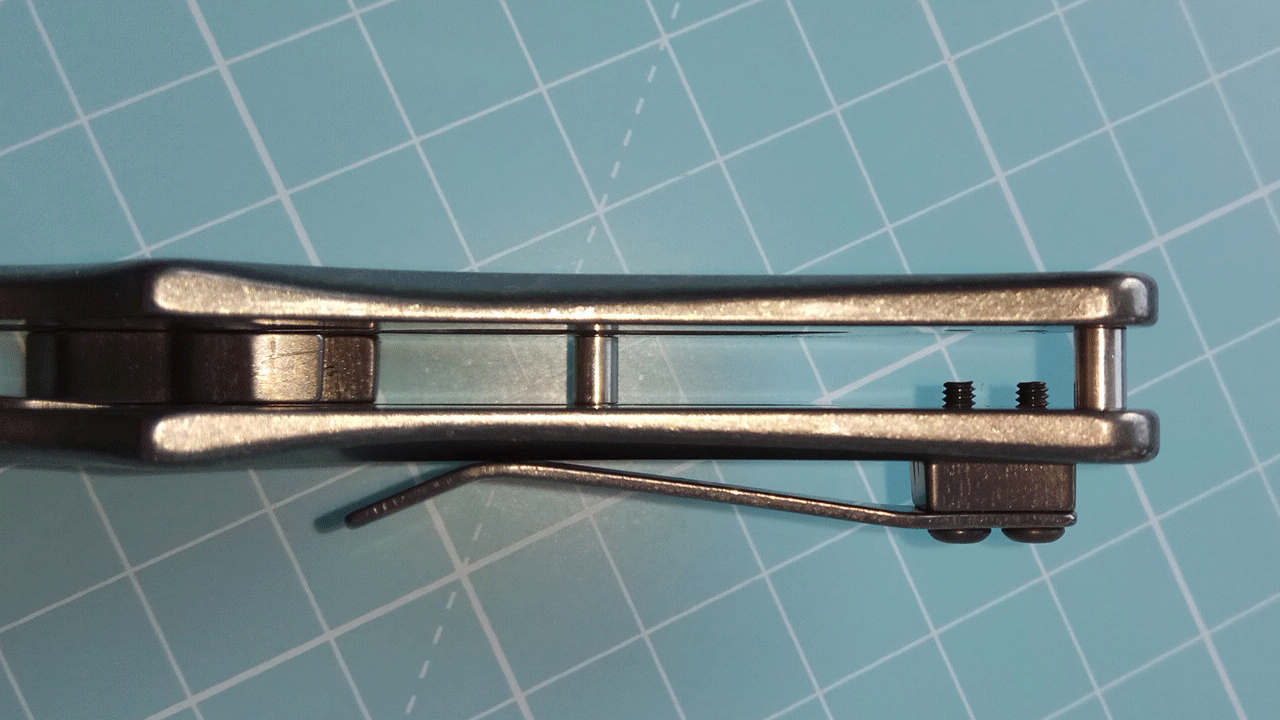
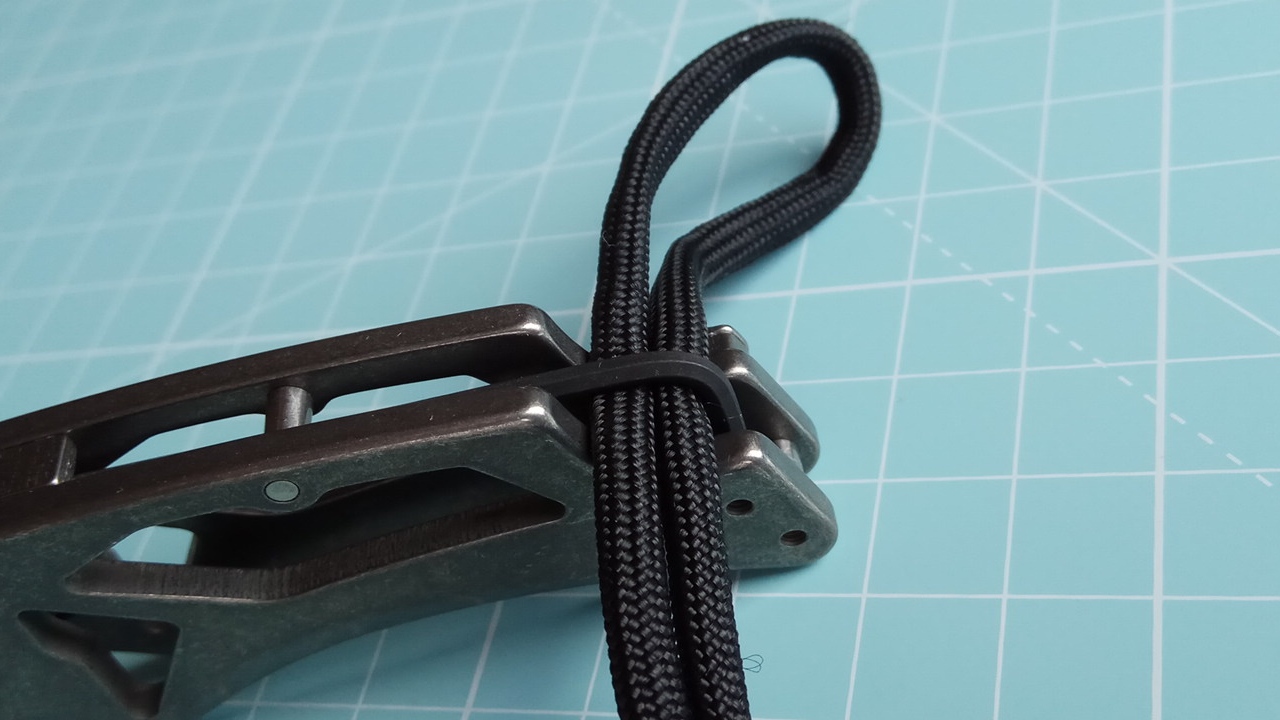
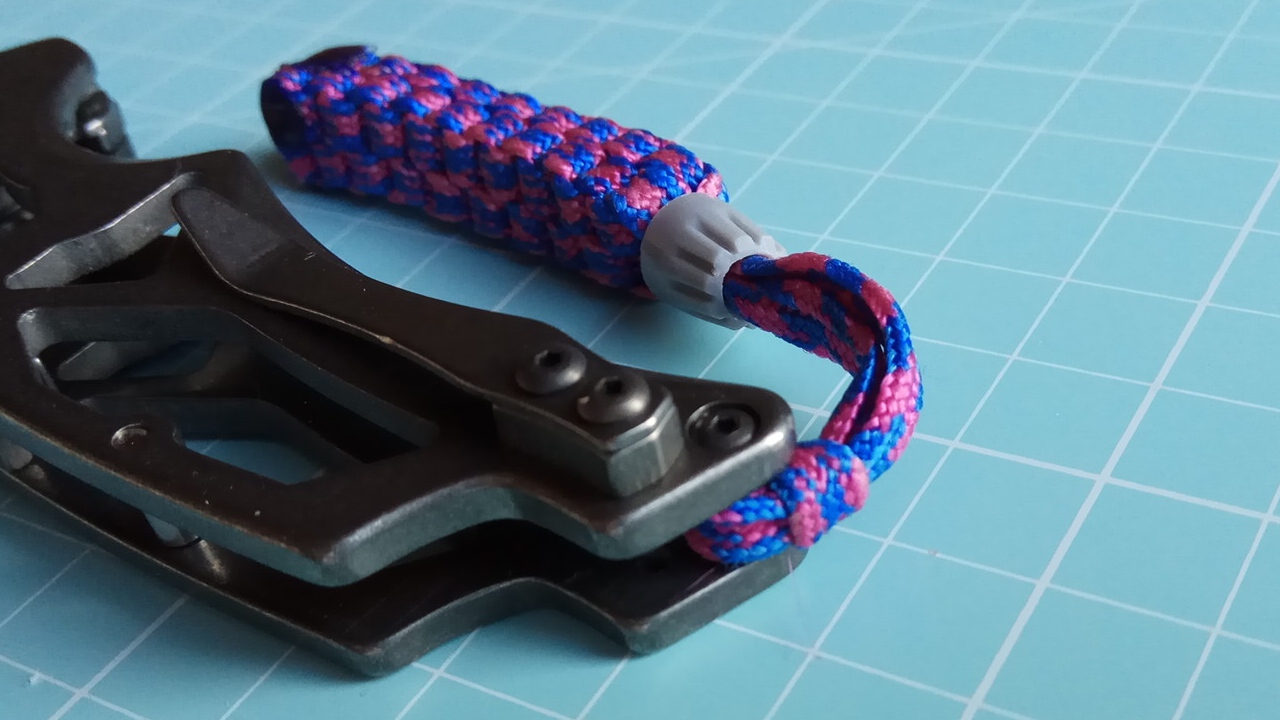

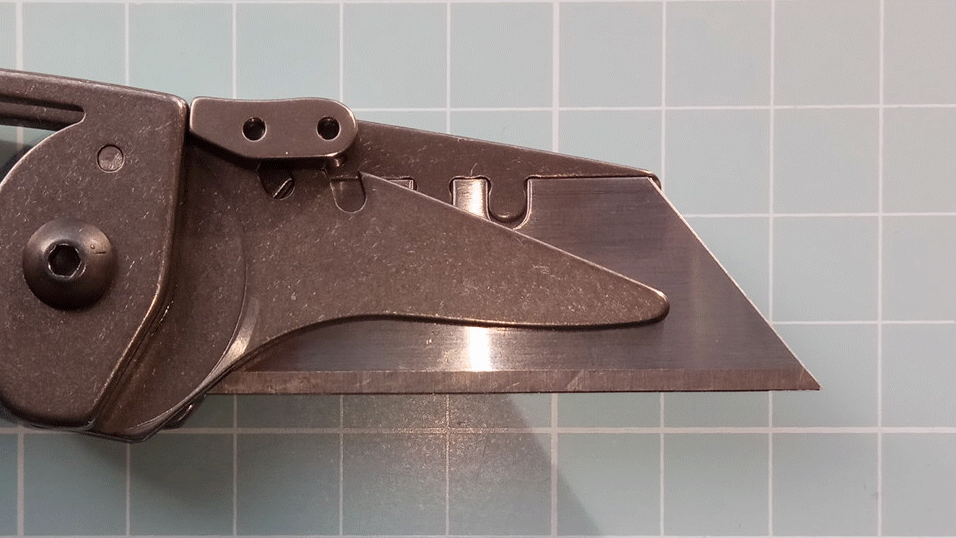
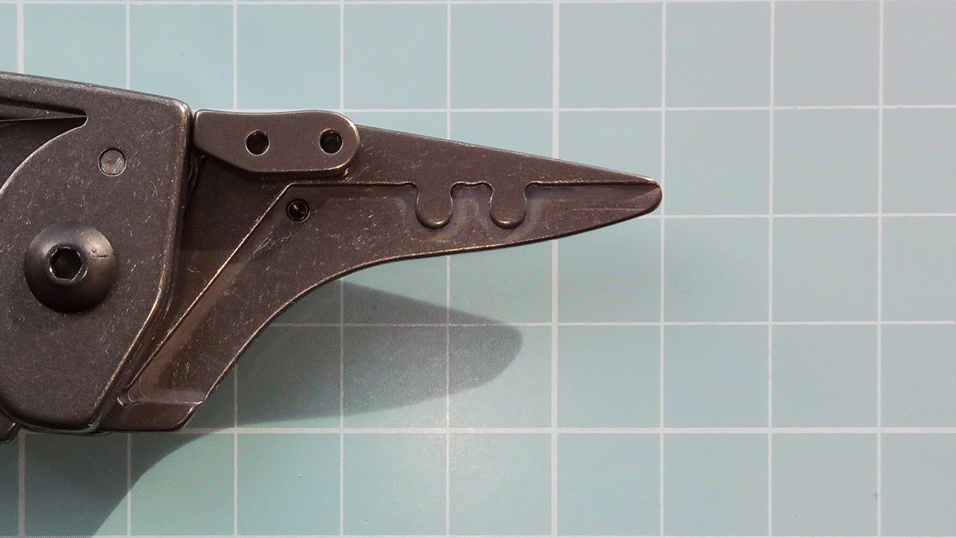
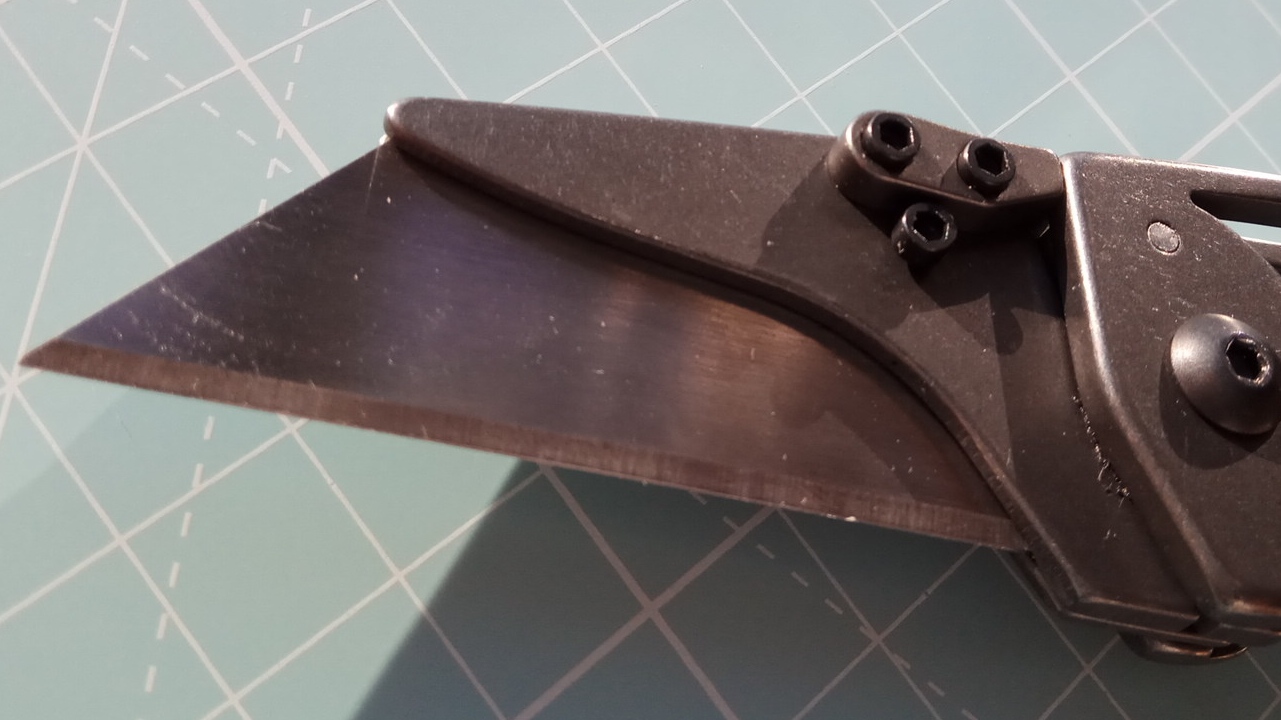
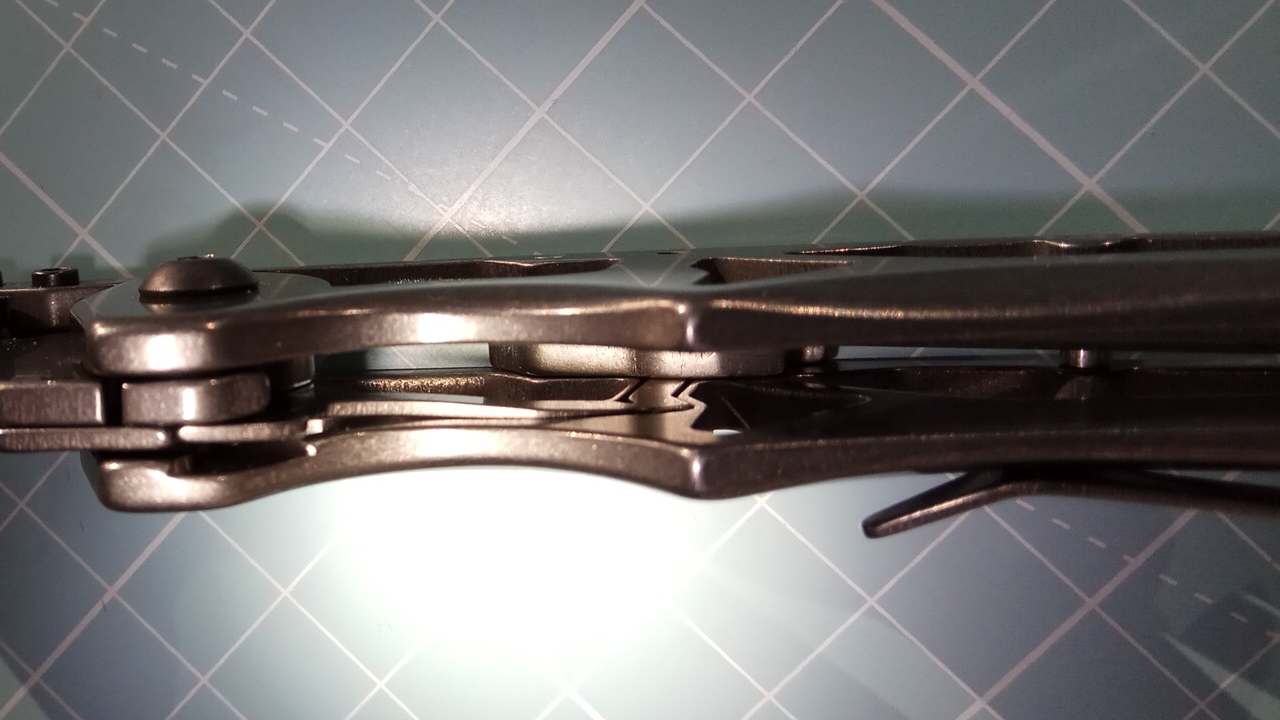
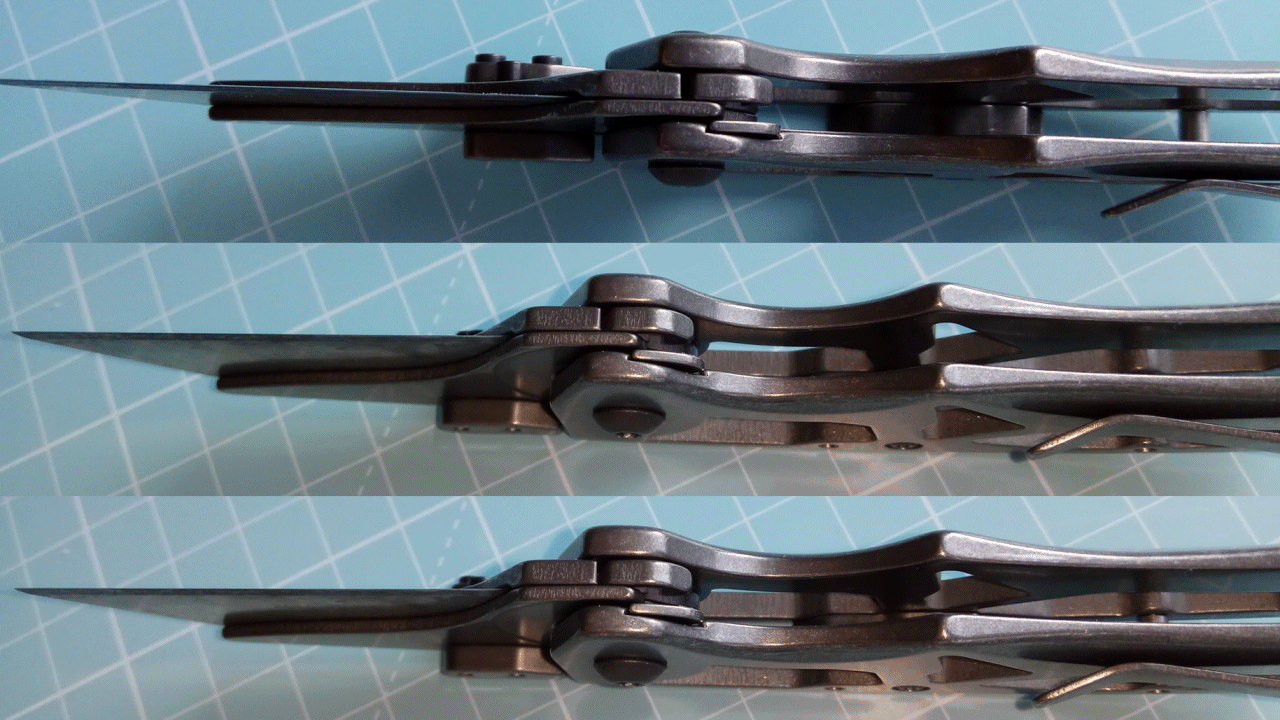
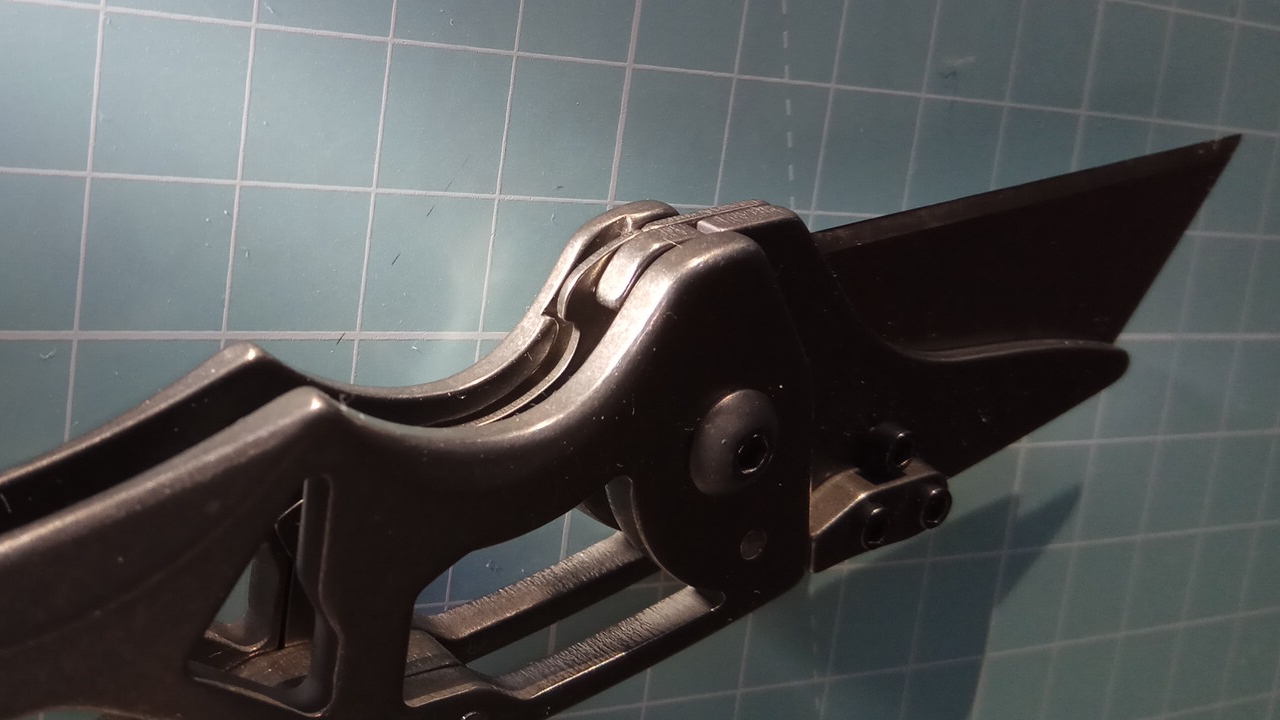
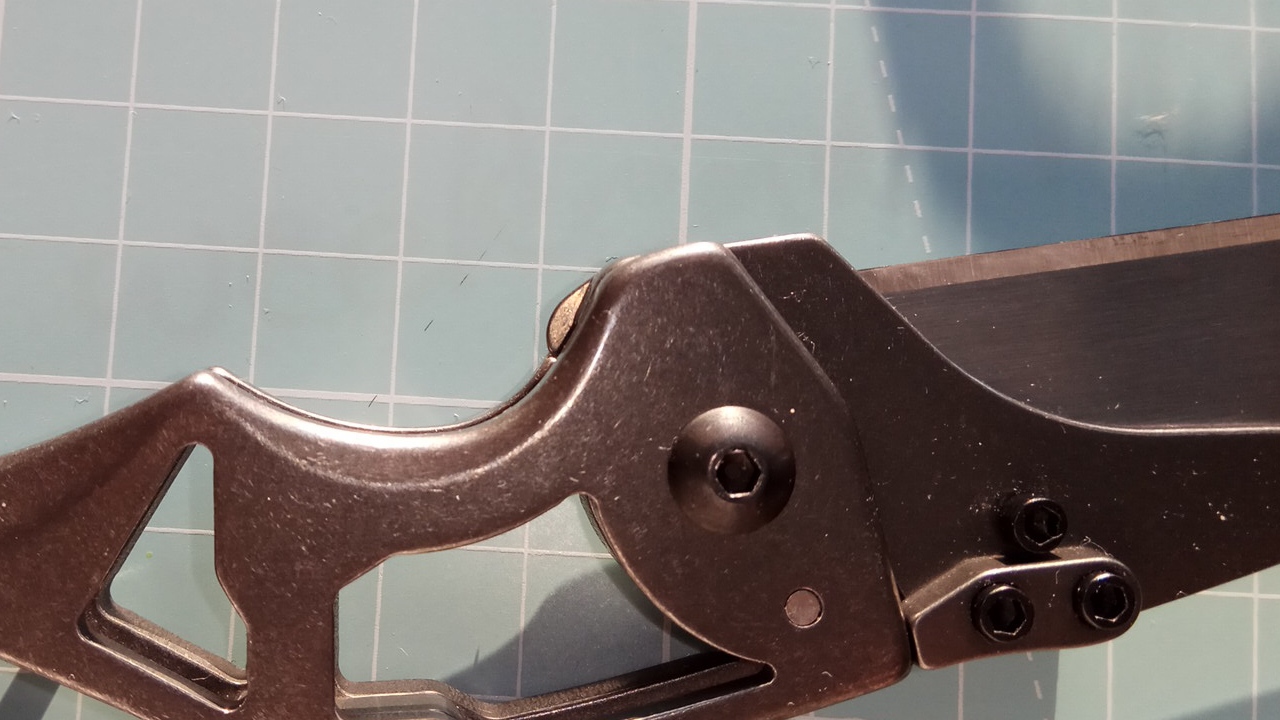
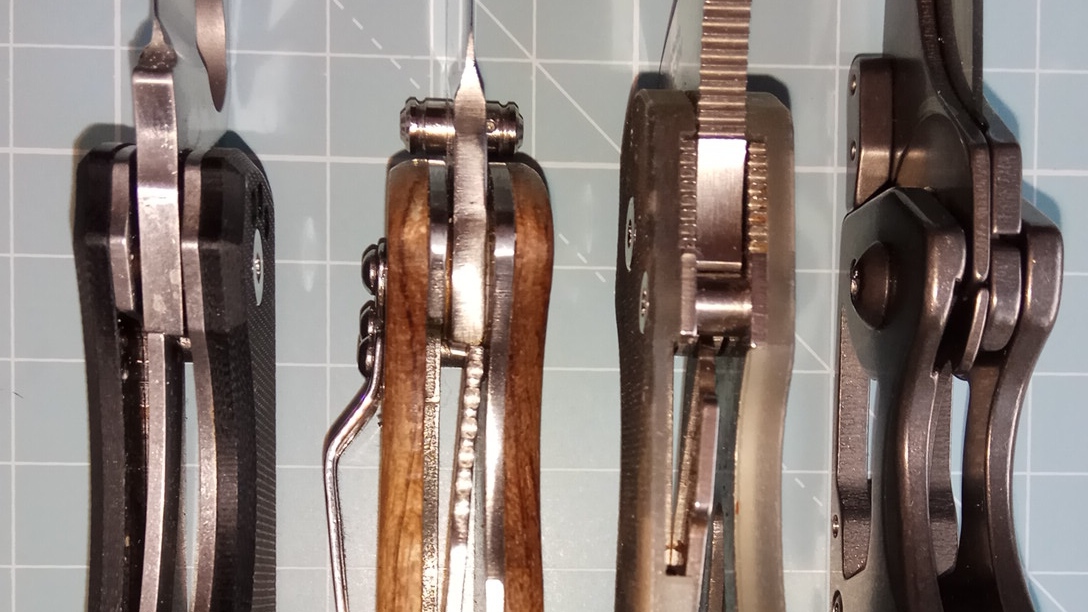
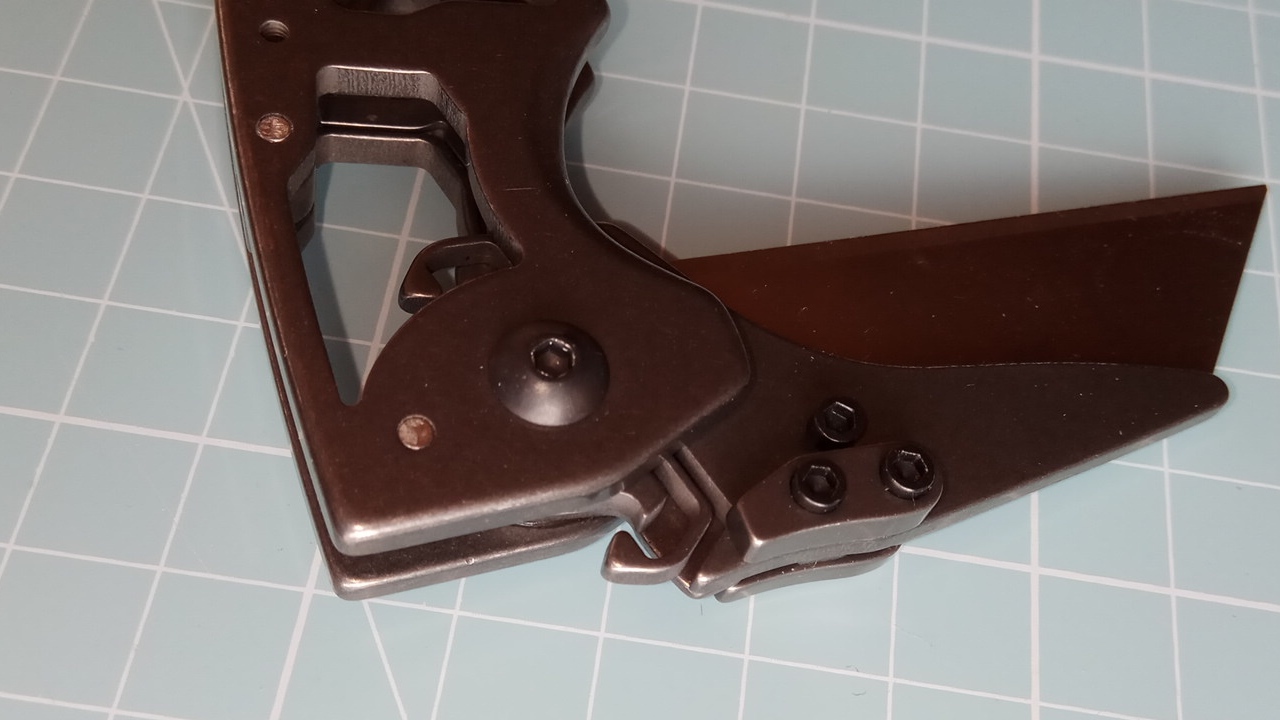
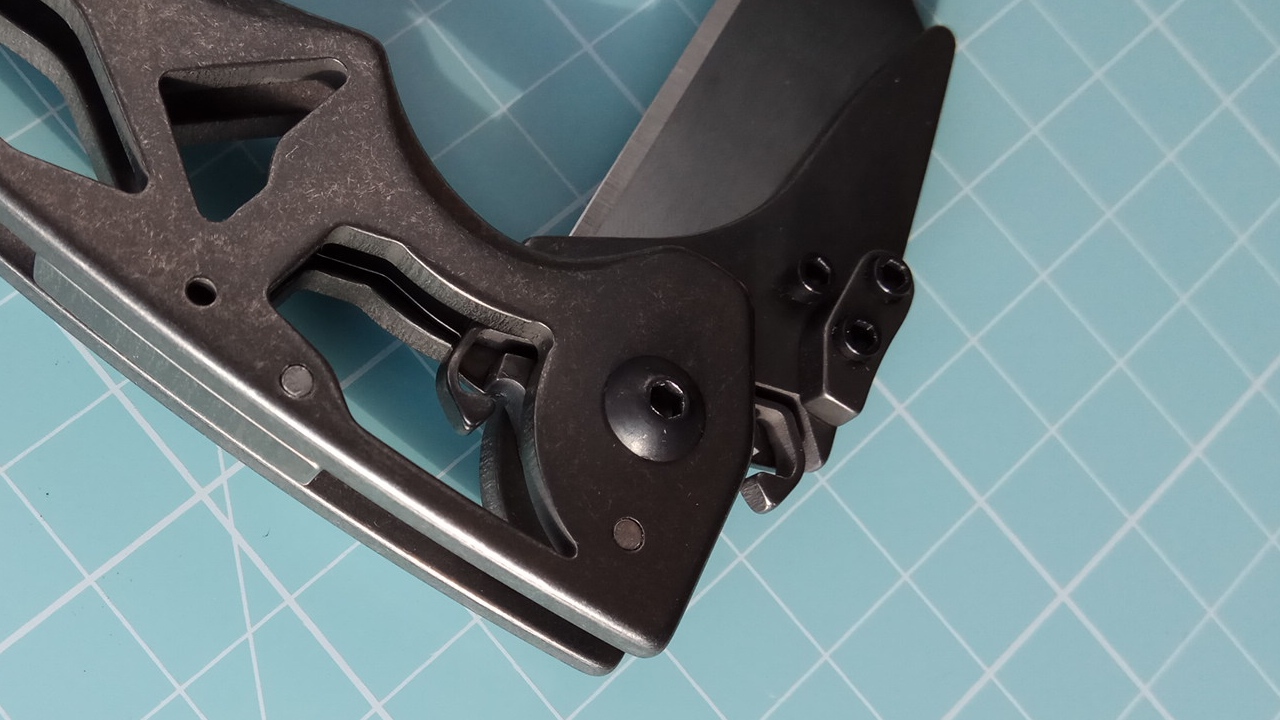
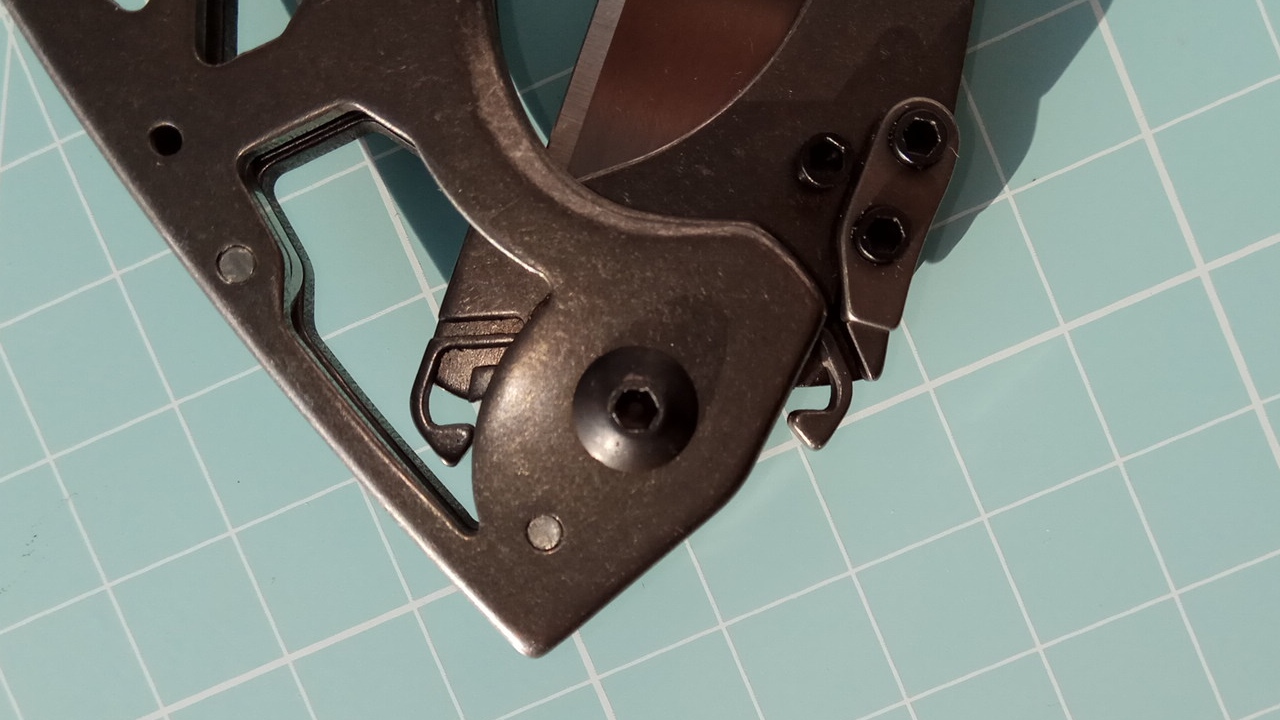
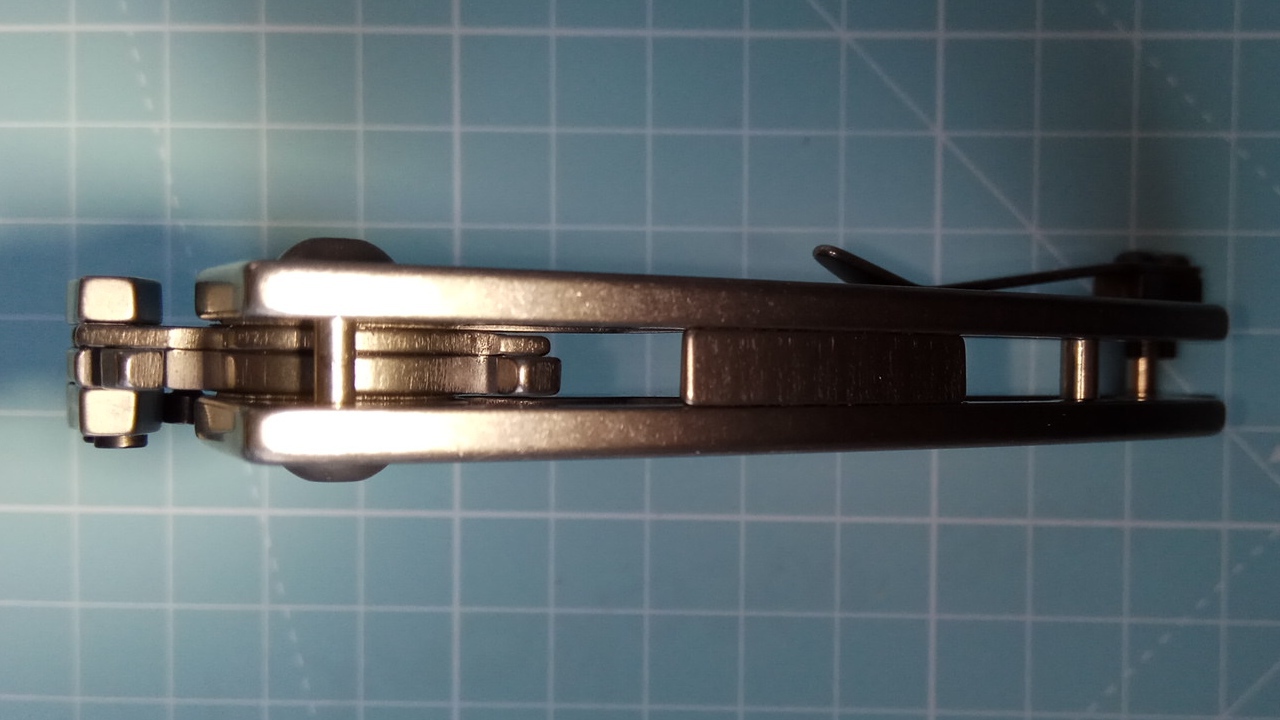
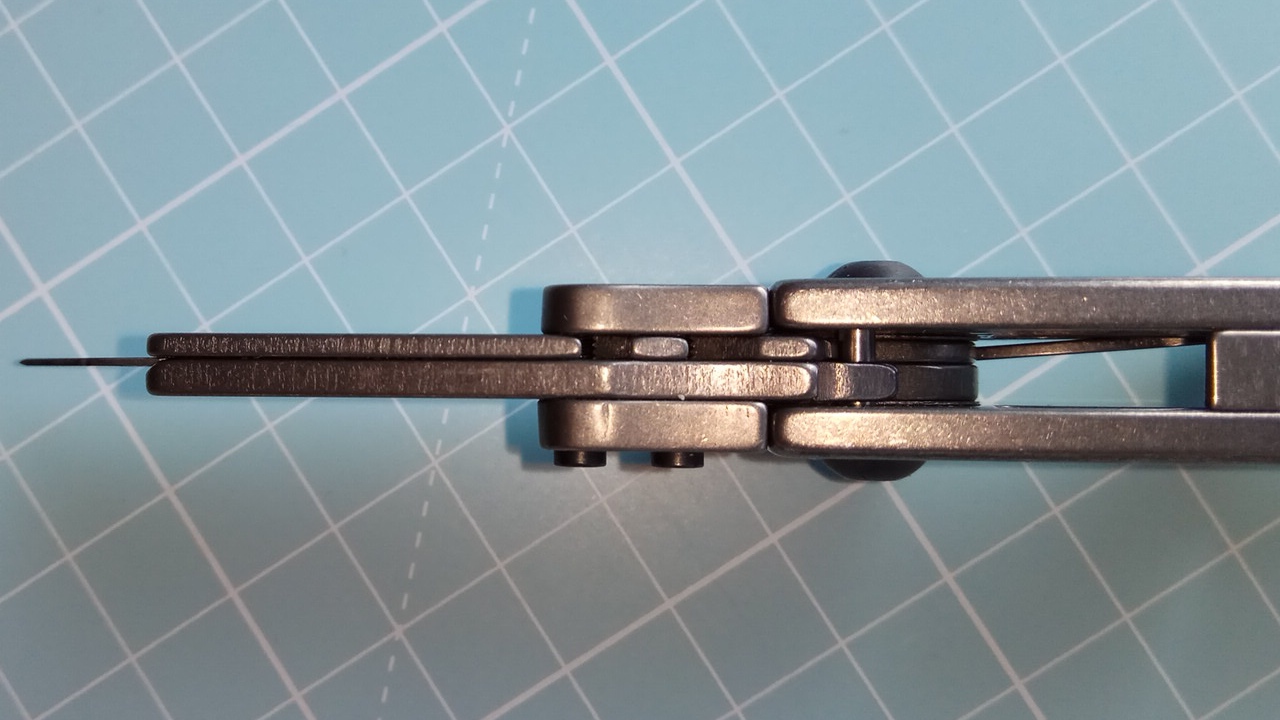
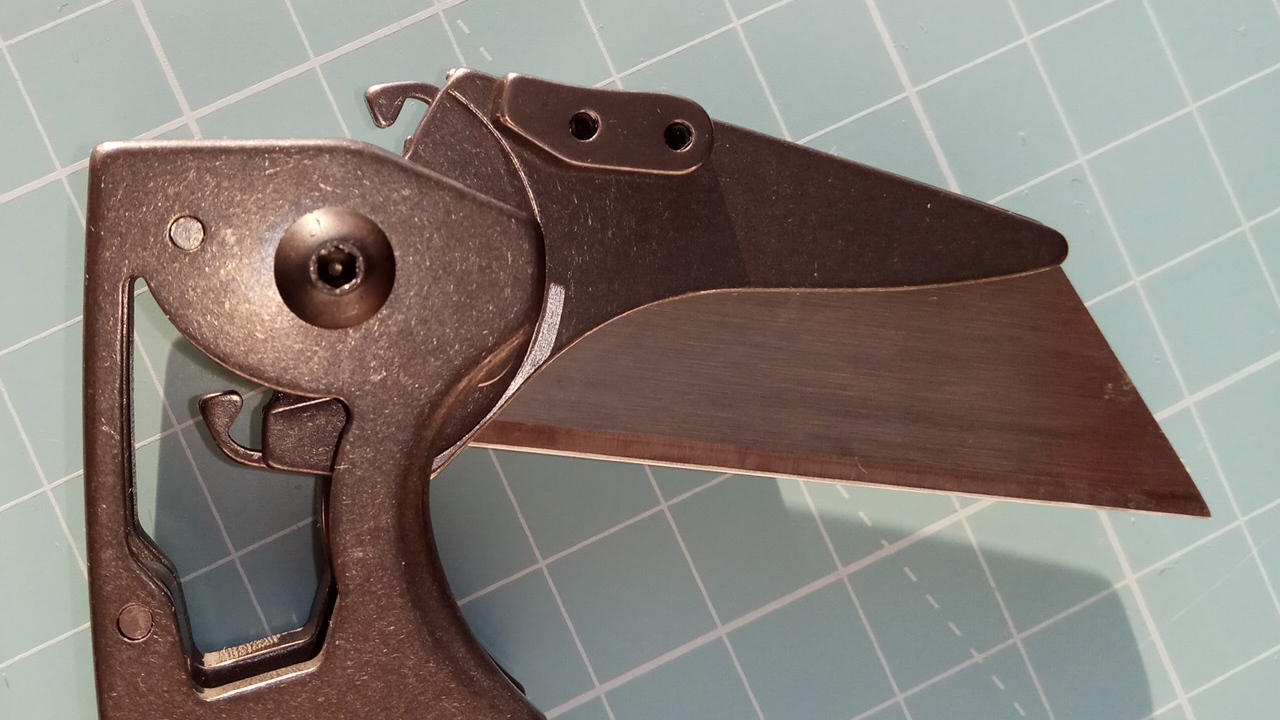
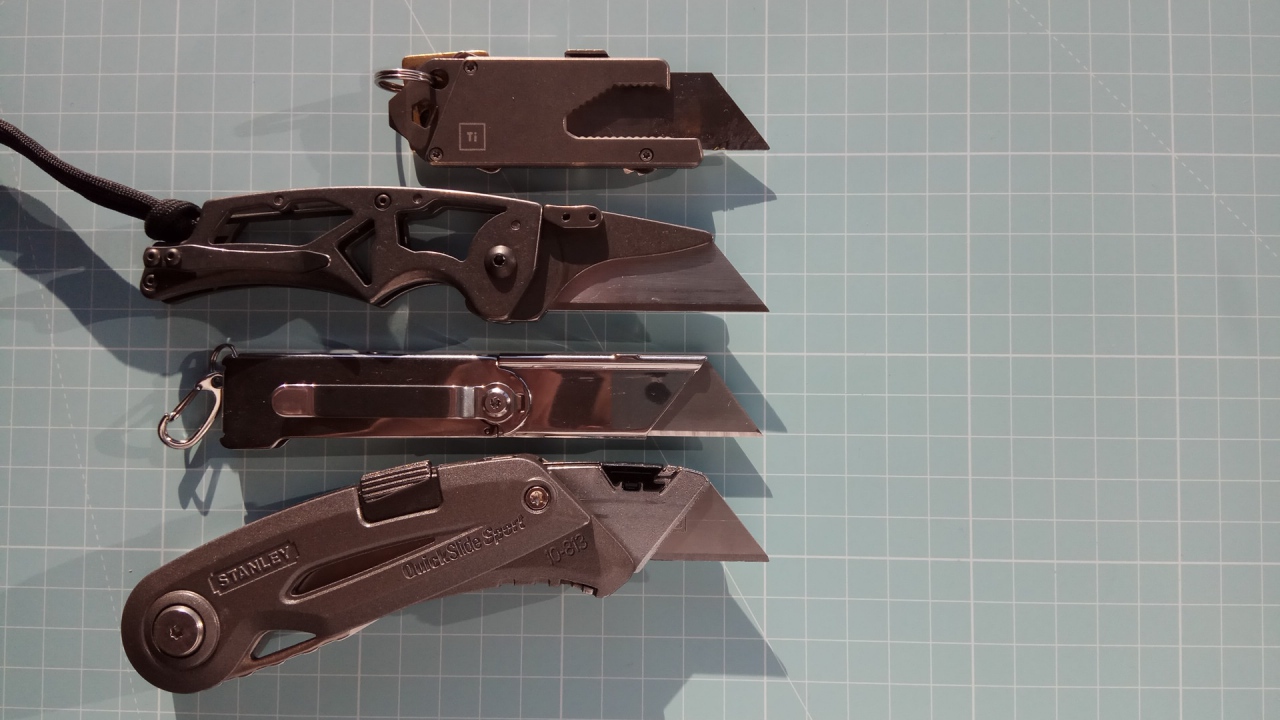
 ), so resharpening utility blades starts to make some sense other than fun
), so resharpening utility blades starts to make some sense other than fun 